16 China and East Asia to the Han Dynasty
Patrick Patterson and George L. Israel
INTRODUCTION
DISCOVERY — Terracotta warriors
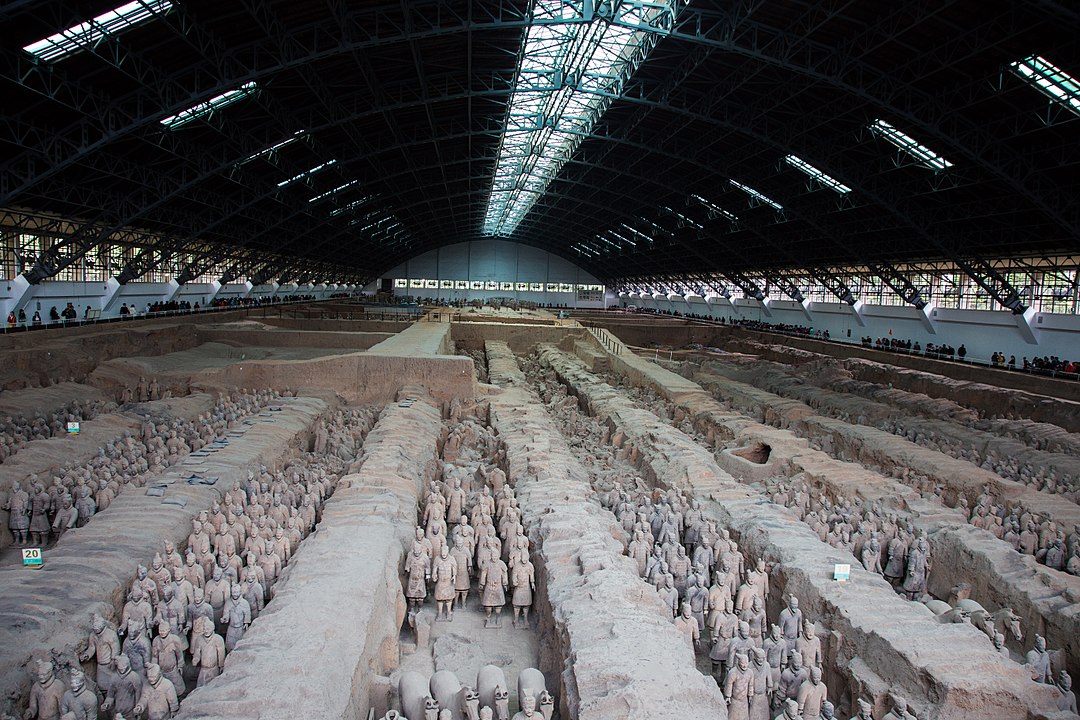
In 1974, farmers digging a well in a field located in northwest China uncovered fragments of a clay figurine. Little did they know, they had chanced upon what has turned out to be one of the most fascinating archaeological discoveries of the 20th century. Subsequent excavation revealed that beneath the fragment lay a massive underground pit filled with over seven thousand terracotta figurines modeling archers, infantrymen, and charioteers. Another pit contained terracotta cavalry and infantry units that likely composed a military guard, while a third one contained high-ranking officers and war chariots in what was perhaps a command post. These three pits are part of a much larger complex of underground vaults spread across twenty-two square miles.
There are a number of unique features to this Terra Cotta army, not least of which is that every soldier has a unique face. There are thousands of these soldiers, all arrayed in marching order, all facing the same direction. They are accompanied by horse-drawn chariots with four terra-cotta horses in harness to pull them. The weapons are accurately rendered. It is as if an army of actual people stand waiting for the commands of Qin Shihuangdi, the emperor of the Qin Dynasty.
Most importantly, a large, forested burial mound towers over the neighboring fields containing these underground armies. This is where the First Emperor of Qin [cheen] was buried after he died in 210 BCE. Although it hasn’t yet been excavated, experts believe the tomb is a microcosm of the emperor’s palace, capital city, and empire. The pits, then, contained the army protecting his realm in the afterlife. With this discovery, our understanding of how China was unified under one empire after a long period of warfare was advanced immeasurably.
It tells us that the Qin Dynasty was much more economically and militarily substantial than historians had long believed. It also gives us a strong sense of the power that the Qin Emperor commanded – the labor and cost to build this army and the tomb that it faces (the tomb appears to have been surrounded by moats filled with mercury, for example) would have been monumental. It must have required thousands of hours of labor and involved the deaths of many of the laborers. That suggests successful political centralization and an efficient enforcement mechanism. In short, the Qin was a sophisticated state with a well-organized army, trade, and tax system.
OVERVIEW
East Asia can be defined in two different ways. Geographically speaking, it is the eastern region of the Asian continent and the countries located there, principally China, North and South Korea, Taiwan, and Japan. But historians also define East Asia as a broader cultural realm that includes countries that both shared close historical relations with China and were impacted by China’s political and legal institutions as well as Confucian and Buddhist traditions. When defined in this way, Vietnam is also included. In this chapter, which serves as an introduction to the early history of East Asia, the focus is on China. China’s early history predates the histories of Japan and Korea. For this reason, we begin in the 2nd millennium BCE with China’s first dynasty and trace Chinese history through to the century. The histories of Korea and Japan are addressed later in Chapter Eleven.
CHINA FROM NEOLITHIC VILLAGE SETTLEMENTS TO THE SHANG KINGDOM
Geography of China
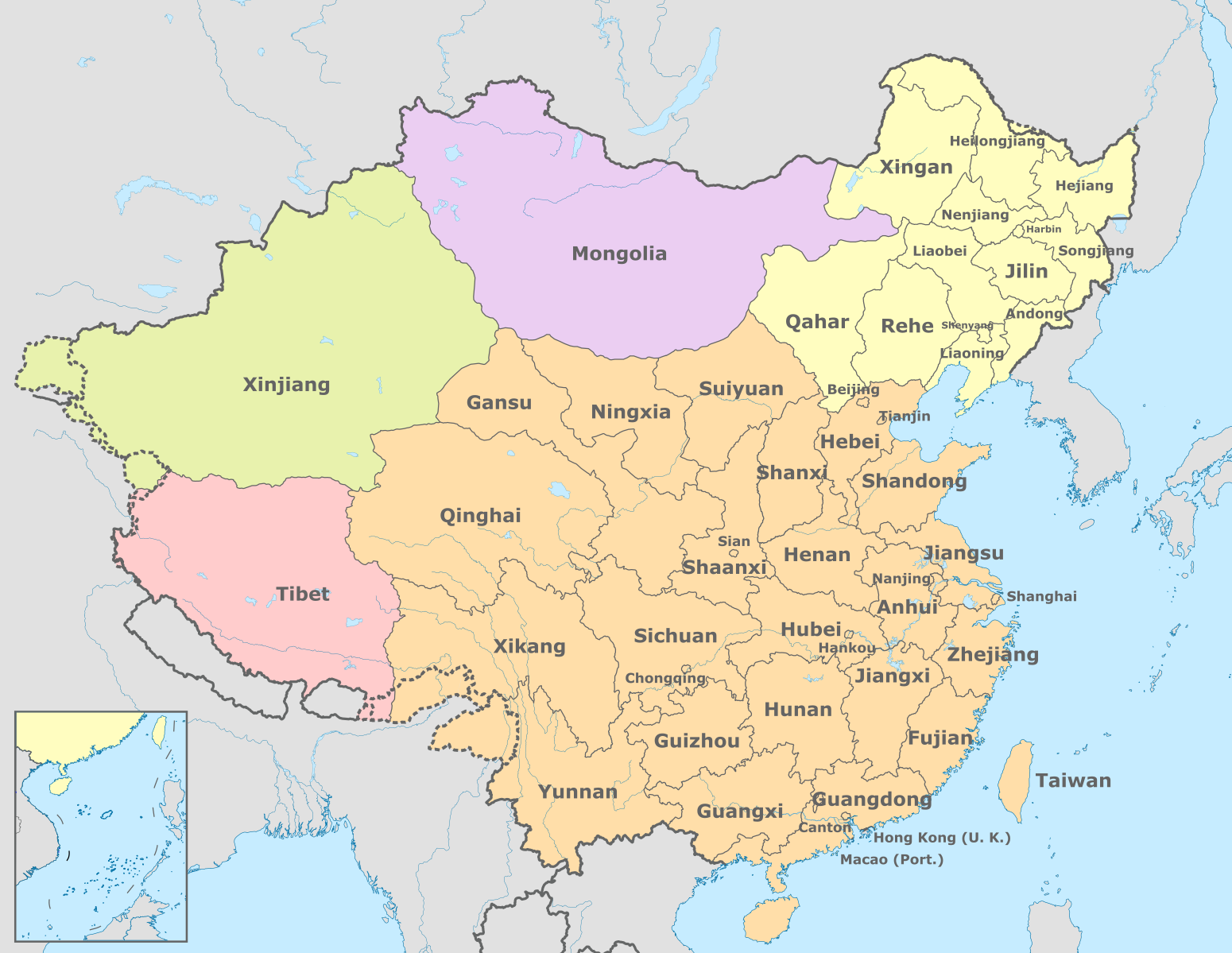
China today is much larger than China was in ancient times. In earlier times, the bulk of the Chinese population lived in “China proper.” This term is used mostly by Western writers to refer to the (ever-changing) historical heartland of ancient China where the Han Chinese language and culture have long been dominant.To the east, China proper is bounded by the Yellow Sea, East China Sea, and South China Sea. The southern boundary is the mountainous jungles of Southeast Asia. On the west and north edges, China meets a transitional zone. Here land suited to agriculture gives way to mountains and plateaus, and in some cases vast expanses of steppe grasslands and desert. Throughout its history, China has become involved with neighboring states and territories. They include parts of the Korean Peninsula, Northeast China, Mongolia, Central Asia, and Vietnam. Sometimes China incorporated these areas directly into the empire. Sometimes they were controlled indirectly as subordinate, tribute-paying states.
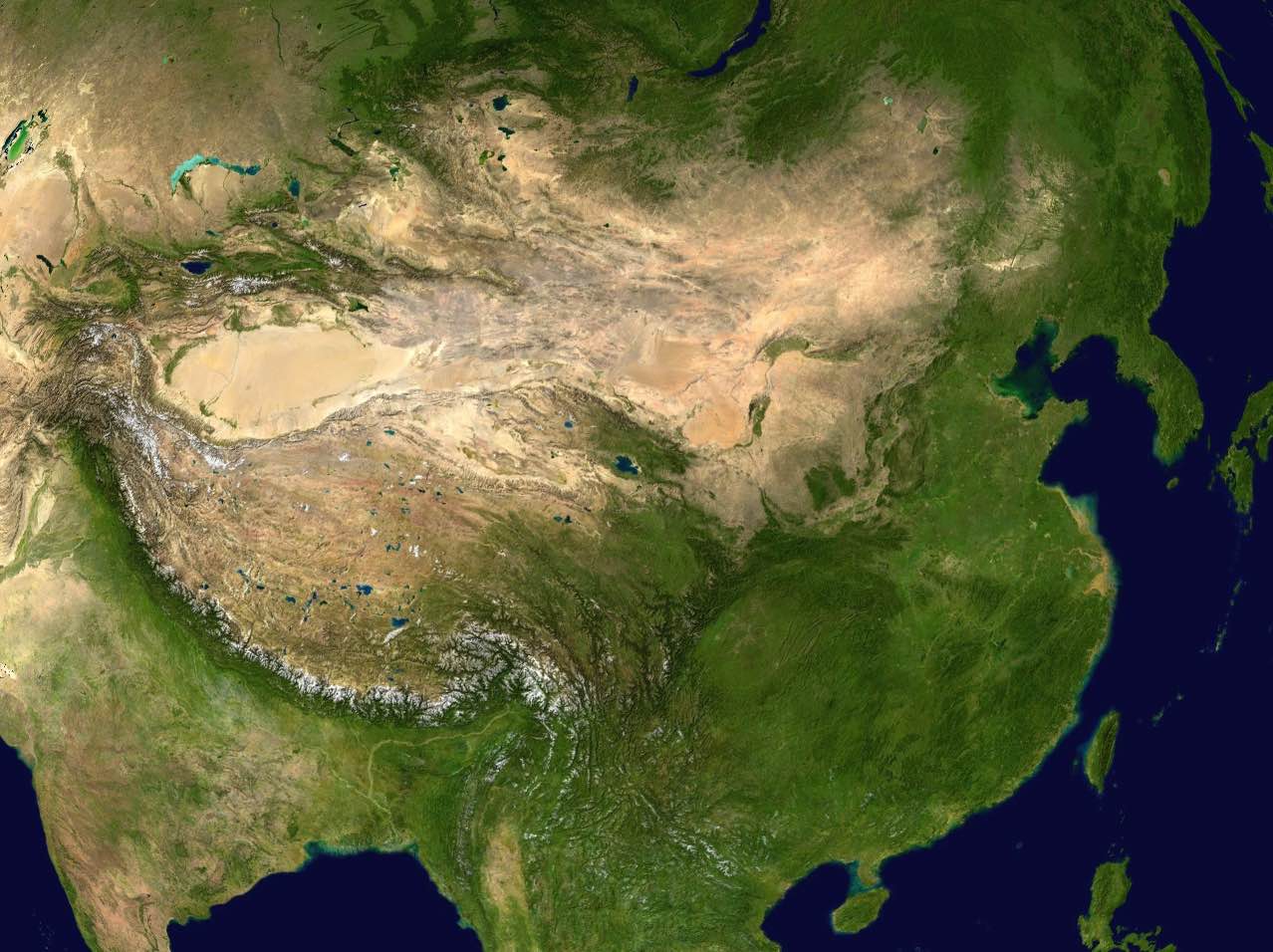
Within China proper, two rivers were particularly important to the formation of agricultural communities that served as the building blocks of Chinese civilization. Those were the Yellow River and Yangzi River. The Yellow (Huang He) River meanders through the northern half of China, where a cool, dry climate is well-suited to wheat and millet farming. Beginning far to the west, this river flows over dusty plateaus. There it becomes muddied with silt called loess, which gives it a yellow color. As it slows, it then deposits this sediment along its middle and lower reaches. The plains surrounding these reaches are referred to as the North China Plain. The productive agriculture made possible by the Yellow River sustained large populations throughout China’s history. However, the Yellow River was and is prone to drought and disastrous flooding. The river’s nickname is ‘China’s Sorrow’ because of the millions killed from the ancient past to the present as a result of its destructive behavior. Historically, this northern region was the heartland of Chinese civilization. The Yangtze River and the surrounding area in South China was just as important. There the weather is warmer and wetter. The Yangtze Basin provides fertile soil for wet rice agriculture. Over time, the early dynasties expanded into the settled agricultural communities in this region.
Chinese civilization developed far from all other early societies. Trade and cultural interactions required traveling great distances using poor transportation technologies. China was isolated from the rest of the world. Geographical barriers in the north included the Gobi Desert and the vast grasslands of the Eurasian Steppe. In the south, it was protected by the mountainous barriers of the Himalayas. To the east, by oceans.
Early Dynasties
Chapters Two and Three covered the development of the first major civilizations of Mesopotamia, Egypt, and India. In each case, rivers were particularly important because they offered a stable supply of water for agriculture. Similarly, in China, the first major states emerged along China’s second longest river – the Yellow River. These states were ruled under the Xia [shee-ah] Dynasty (c. 1900–1600 BCE), Shang [shawng] Dynasty (1600–1046 BCE), and the Zhou [joe] Dynasty (1045–256 BCE). Each of these kingdoms was ruled by a line of hereditary monarchs hailing from one lineage, which is why they are also referred to as dynasties.
Because written sources don’t become available until the Shang Dynasty, historians have relied heavily on the archaeological record to reconstruct the process by which these states arose. Looking back at the end of the Paleolithic era (c. 10,000 BCE), East Asia was sparsely populated by bands of foragers living in temporary settlements. During the 8th millennium BCE, some of these hunter-gatherers turned to domesticated cereals for a stable food supply and settled into villages so they could cultivate them. Thus, the Neolithic Age (8000 – 2000 BCE) commenced.
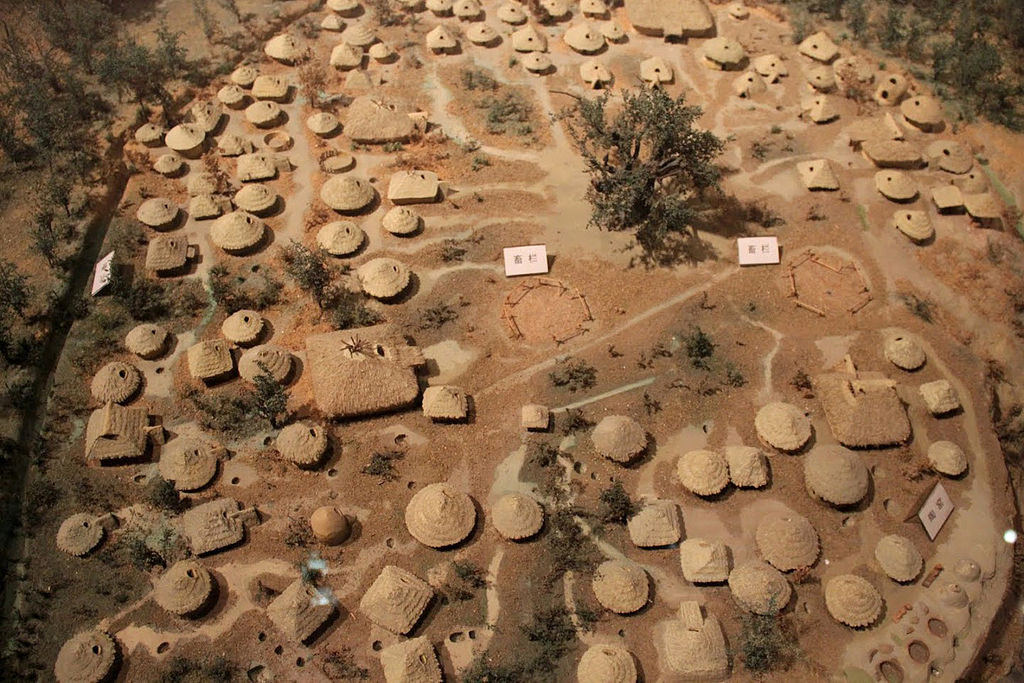
Over the course of those six millennia leading up to the Xia Dynasty, Neolithic communities became more diverse and complex. For instance, archaeologists identified at least eight major regional Neolithic cultures that existed during the period 5000–3000 BCE, located along rivers and coasts. They did so by examining pottery styles and village settlement patterns. One example is Yangshao (painted pottery) culture, which was concentrated along the middle reaches of the Yellow River. The “Painted Pottery”, or Yangshao, culture grew rice and created high-quality pottery and Neolithic tools. Over one thousand sites left behind by millet-farming village communities have been discovered. Jiangzhai (c. 4000 BCE), for instance, was a moated village settlement that occupied roughly thirteen acres. It was composed of related lineages and was tribal in its organization.
During the 3rd millennium BCE, Yangshao culture was gradually supplanted by Longshan culture (c. 3000–1900 BCE), which emerged further to the east along the middle and lower reaches of the Yellow River. In 1928, when archaeologists excavated a site near the town after which Longshan was named, they found evidence for a culture that had laid the foundations for the kingdoms that emerged in the 2nd millennium BCE, including the ruins of numerous walled towns with cemeteries outside. Their rammed-earth walls protected urban areas with public buildings, roads, and drainage systems. The cemetery’s arrangement suggests that people living in the towns were buried alongside fellow clan members, and also that some members were wealthier and more powerful. Most graves had nothing but a skeleton. Others contained numerous artifacts, such as pottery and jade.
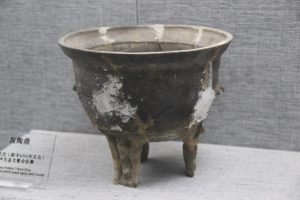
Based on this evidence, archaeologists conclude that, during the 3rd millennium BCE, some of the growing population shifted from villages to walled towns. These walled towns developed into political and economic centers, exercising control over and serving as protection for surrounding communities. Individuals with more elaborate graves were likely political and religious leaders and served as chieftains. Numerous competing chiefdoms emerged, providing the foundation for more powerful kingdoms to follow.
Ancient Chinese histories identify the first major kingdom as the Xia Dynasty (c. 1900 BCE–1600 BCE). However, these histories were written many centuries after this kingdom about which they speak, and, lacking written evidence from the dynasty itself, specialists have been unable to definitively establish its location. Nevertheless, most agree that the Xia capital was located along the Yellow River at Erlitou [are-lee-toe]. At its peak of activity from 1900 BCE–1600 BCE, this town looked like something more complex than a chiefdom. Erlitou included a central, walled palace complex, workshops for the production of bronze and pottery, and elite burials containing bronze weapons and jade, suggesting a socially stratified, Bronze Age civilization and kingdom. That is why many historians identify it as the capital of the Xia Dynasty.
Environment in History – Yu the Great Tamed the Yellow River
China is the oldest continuous civilization in the world. Chinese intervention in the natural environment is also among the oldest continuing efforts in human history. It has had a significant impact. T.R. Kidder, Ph.D., an anthropologist at Washington University in St. Louis has found evidence of a great flood of the Yellow River 4000 years ago that may have been the catalyst for the development of China’s first dynasty. China, it turns out, has been engineering the course of the Yellow River for 4000 years, and may have made the Yellow River’s tendency to flood even worse. Kidder says “In some ways, these findings offer a new benchmark for the beginning of the Anthropocene, the epoch in which humans became the most dominant global force in nature” (Newitz 2016). Hydrology revitalized neolithic China and created the seed that became the great state we know today. But at what price?
The findings are stunning to historians of China, who up until 2016 assumed that the Xia Dynasty was probably at least partly mythological. Scholars now acknowledge the Xia Dynasty as having actually existed. That recognition is directly tied to the discovery of the great flood – one of the most catastrophic flooding events in the last 10,000 years. According to the findings of Wu Qinglong, Ph.D. in geography at Nanjing Normal University, sometime around 1920 BCE in what is now Qinghai Province an earthquake occurred that created a natural dam on the course of the Yellow River, stopping its flow and creating a great lake. At an ancient neolithic site known as Lajia, a group of human skeletons were found in association with cooking utensils on the floor of a dwelling. The skeletons were covered in soil and rock of mixed ages, consistent with the damage done by a powerful earthquake. On top of this layer of earthquake debris is a slightly later deposit of flood debris. The skeletal remains under all of this date to 1920 BCE. Combined with other geological evidence, the researchers have built a story of the great flood that devastated China’s neolithic Yellow River societies and probably triggered sudden growth in a highly centralized, highly organized new society built on their ruins – what we now know as the Xia Dynasty.
The Yellow River’s nickname “China’s Sorrow” comes from its historical tendency to overflow its banks. Originating in the great alluvial plain known as the Mongolian Steppe, the Yellow River flows deep and fast into the rich valley of northern China. There it begins to curve. Through many curves, it slows down and the flat, soft valley floor allows it to spread out to nearly 4 kilometers wide, where the flow becomes a meandering crawl. During its early run in the north, it picks up loess – the fine soil blown and sifted by the wind on the steppe. That loess floats on the fast-flowing river. As it slows and twists and turns along the southern part of its course in the North China Plain, the river drops that loess to the bottom. In this way, the Yellow River builds up its banks over time. In places, the river bed runs above the plain. When the river breaks its banks, tens of thousands of square kilometers of agricultural and settlement land can be flooded. These floods happen quickly; with little warning, they destroy crops, cities, roads, and bridges.
Eventually, that lake overtopped the natural dam in an “outburst flood” that would have quickly overwhelmed everything downstream. This included not only human structures but geological ones. The high river banks that the river had carved before the earthquake dammed it were likely flattened by the great rush of water. That made flooding much more likely in the years after the quake. The flood also appears to have devastated the neolithic societies along the river basin. After a short period of what may have been recovery or of consolidation, a new centralized and sophisticated society known to archaeologists as the Erlitou culture arrived, according to David Cohen, an anthropologist at the National University of Taiwan.

This may have been the beginning of the Xia Dynasty, and claims of taming of the Yellow River became a way for the kings of Xia to claim legitimacy. There is no evidence remaining of human hydrologic engineering of the river. However, the evidence of the flood is consistent with stories from the beginning of the Xia Dynasty. Lack of writing at the time means that historians have to rely on stories passed down, then written hundreds of years later during the succeeding Shang Dynasty. The Xia was said to have been founded by a culture hero named Da Yu, or Yu the Great. Culture heroes are usually not actual people, but amalgamations of groups of people given the status of a single individual to make story-telling easier in pre-literate societies. Thus it is no surprise to find that we have no evidence of the existence of King Yu. However, at least some of the culture heroes of China were probably based on real people. King Yu the Great may be one of those. Yu was credited with the taming of the Yellow River. Most likely, and based on the written histories from later dynasties, this was achieved through dredging a new deep course for the waters of the river, and “(t)he story of Yu taming the flood is the story of a new political order emerging out of the chaos of the flood” (Normile 2016).
Yu likely represents all of the people who worked on the system of dykes and channels that eventually did establish the river within its banks. Those people probably worked for the king in a system of required labor levied as a kind of tax. In this system, each Chinese household would provide a certain number of man-hours of labor to the king each year. Scholars call this labor tax “corvee”. These workers may well have taken 30 years to create the first successful water control system. They may have been managed for all or part of that time by a man named Yu. It is common in legends to give credit to one person for all that work. It is also common to explain feats of engineering that may have even seemed magical at the time to spirits and gods.
Researchers, including Kidder and his research partner Liu Haiwang, senior researcher at China’s Henan Provincial Institute of Cultural Relics and Archaeology, argue, however, that this may be the beginning point of a long history of engineering the course of rivers in China, engineering that has had increasingly catastrophic effects on human settlement and the environment. As with the dredging, and creation of dykes and canals on the Mississippi in the 20th century, and the Indus River in ancient times, this engineering seems to have made floods much worse. Yu’s supposed efforts deepened the course of the river. That allowed more water to flow more quickly. This probably created the conditions for a massive flood later in 14-17 CE that killed millions and may have been a key reason for the fall of the Han Dynasty.
In fact, since the time of Yu, the Yellow River has broken through its banks and flooded the North China Plain hundreds of times. The most recent flood of the Yellow River occurred in 1958. Prior to that, the river flooded in 1938. This time the flood was intentionally caused by humans. During its fight with Japanese invaders, China’s Nationalist Army blew up dykes holding in the river. They did this to create a flood to slow down the Japanese advance. Strategically it was a failure. Socially and geographically it may have been the worst human-induced disaster in history. The flood was so catastrophic it killed an estimated 500,000 people. The water destroyed 50,000 square kilometers of farmland.
The river has changed its course numerous times because of these floods. The most recent example happened in 1851. This flood actually moved the river, sending it into the Bohai Sea rather than the Yellow Sea. It should come as no surprise that the value of living and farming in the North China Plain was always balanced by the risk that the Yellow River would flood. During the 19th century, it happened roughly every twenty years. The river truly has been a source of China’s Sorrow.
THE SHANG DYNASTY
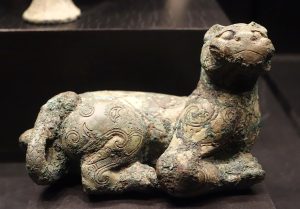
The Shang Dynasty (1600–1046 BCE) is the beginning of China’s historical period, known through identifiable remains and some extant textual sources. The most important source for understanding Shang Dynasty history has been oracle bones. In 1899 in an apothecary, a Chinese scholar came across mysterious bones with Chinese characters inscribed on them that were being ground up for use as medicine. He immediately recognized that the Chinese characters inscribed on them were very ancient. Subsequently, the origin of these bones was traced to fields in Anyang [ann-yawng]. Beginning in 1928, archaeologists began excavations in the areas where the oracle bones came from. These excavations revealed a treasure trove of information about the Shang Dynasty. Similar to the discovery of the Indus Valley Civilization, a lost civilization was revealed on the North China Plain, the one difference being that traditional histories of a later time had hinted at the existence of this one. Still, until the discovery of the oracle bones, the Shang Dynasty was considered by some historians to be a myth. Now there was evidence.
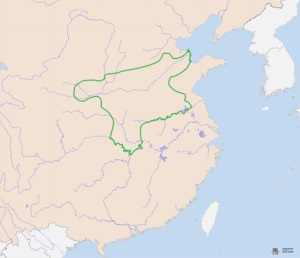
Learning in Action – Shang Tomb Artifacts
View website: “Shang Tomb of Fu Hao”, A Visual Sourcebook of Chinese Civilization prepared by Patricia Buckley Ebrey
Link: https://depts.washington.edu/chinaciv/archae/2fuhmain.htm
The findings were substantial. A diverse array of settlements existed in the north China Plain, with a royal capital at the center near what is now Anyang, covering nearly 30 square kilometers. Archaeologists have identified 53 rammed earth foundations as the floors of royal palace-temples. The ruins in their vicinity were residential areas for elites and commoners, sacrificial pits, and workshops for the production of bronze, pottery, and stone. A royal cemetery with eight large tombs and dozens of smaller ones lay to the northwest. The larger graves were roughly half the size of a football field, each accessible through four ramps whose orientation to the cardinal directions gives them the appearance of crosses. Deep down at the bottom of each tomb’s central shaft, wooden chambers were built to house the bodies of Shang kings. Dozens of human skeletons were placed above and below these, presumably as servants to accompany rulers in the afterlife.
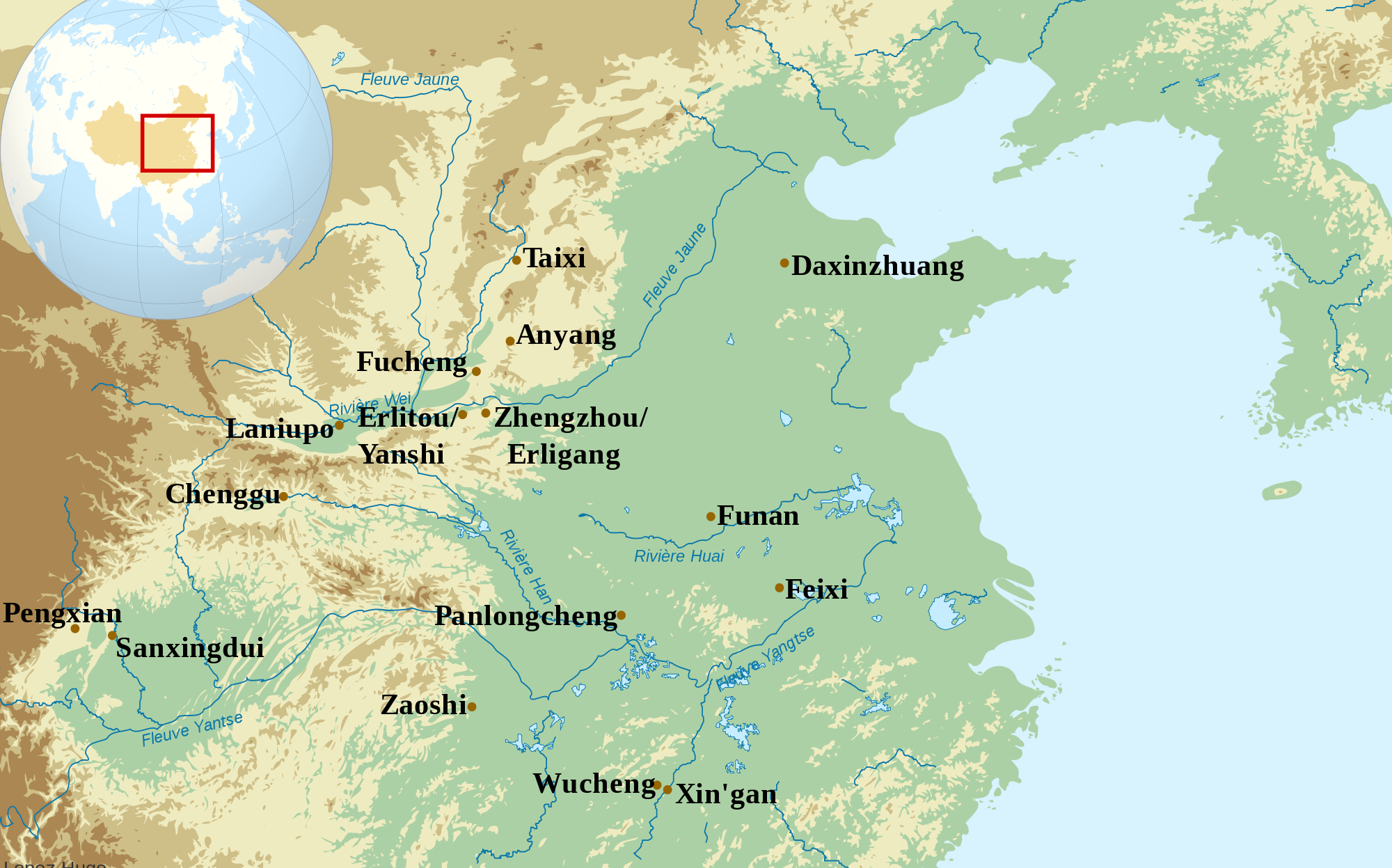
Anyang served as the last capital of the Shang Dynasty, from 1200 to 1046 BCE. It was at the center of a loosely governed territorial state located on the North China Plain. Shang kings directly governed the capital and its vicinity, but likely controlled areas farther out by building confederations with locally powerful lineage chieftains, and maintained relations by regularly hunting, warring, and carrying out rituals with them. Some of those leaders were directly related to the Shang kings, and some were allies by marriage.
The oracle bones are the most important source for understanding this kingdom. Most of the 200,000 fragments found so far are either turtle plastrons or scapula from cows. Interestingly, these were used for divination, which is why they are called oracle bones. When Shang kings or their diviners sought to know the future, they would proceed to a temple erected in honor of a Shang deity or the spirits of deceased ancestors in the royal line. Before a stone tablet, they would make a statement about what might happen (for example, “It will rain,” or “If we attack the Mafang [high god], Di will confer assistance on us”), and then apply heat to a hole bored into a bone until it cracked. The crack was viewed as the response from the god or spirit. The king would then determine whether or not it was auspicious, and a record would be inscribed on the bone, sometimes including the actual outcome. From these we know that Shang elites believed that a high god Di, nature gods, and the spirits of deceased kings controlled the future. That is why Shang kings had massive bronzes cast and carried out sacrifices to them. The bronzes were filled with food and placed at the temples, literally to feed the spirits. Likewise, the sacrificial pits show that a substantial shedding of blood for these higher powers was a regular occurrence. Shang elites worshiped their ancestors and frequently used divination to determine their will. Rulers were buried in grand style, with war chariots, and often with their servants, who were sacrificed to provide them assistance in the afterworld. Peasants were usually buried with barely any grave artifacts at all.
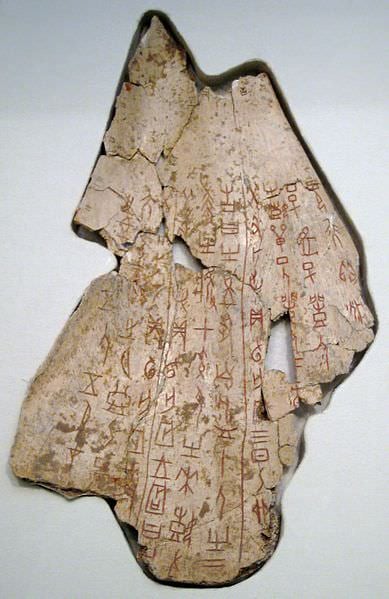
THE LONG ZHOU DYNASTY (1046–256 BCE)
After the Xia and Shang, the next major dynasty in Chinese history was the Zhou Dynasty (1045–256 BCE). In 1046 BCE, a Zhou king overthrew the last Shang ruler and established control over much of northern China. In the early centuries of Zhou rule, during the Western Zhou (1046–771 BCE), Zhou kings dispatched kinsmen to territories he granted to them. These nobles were allowed to rule their own hereditary lands so long as they observed certain obligations to their king. Shang rituals, including divination and religious beliefs, continued with no break–even ritual vessels remained the same.
The Zhou were so successful in their military adventures that they ultimately came to control more territory than the Shang had ruled. To justify their conquest, they made the claim that the last Shang king was corrupt and evil, and they were chosen to fix the situation. Since the Zhou Dynasty’s chief deity was T’ien or Heaven, the Zhou claimed that they had been chosen by T’ien for this responsibility and T’ien had guaranteed their victory over the Shang. This support created an awesome responsibility for the ruler to care for China and the people who ruled, or he would lose his “mandate”. This ruling philosophy became known as the “Mandate of Heaven” and was used for millennia by China’s emperors to justify accession to power and the legitimacy of their dynasty. Signs that a dynasty had lost the Mandate included political upheaval, increased security problems (border raids and threats), and natural disasters. Such troubling events, especially if severe, were interpreted as evidence the gods/Heaven were unhappy with the existing political situation. In secular terms, these occurrences indicated inept leadership and an unhappy populace. Either way, these crises signaled the end of the dynasty.
The Zhou Dynasty claimed a new Mandate and established a new dynasty, but did not change the basic structure of the Chinese state and wielded only limited central power. Local warlords continued to hold onto much of their regional power which meant continuation of a shaky central leadership. But over time, Zhou kings lost their ability to control these lords, and the lords became increasingly independent. In 771 BCE, in what became a telling sign of weakness, the Zhou king was murdered and his young successor was compelled to relocate farther east, to a capital closer to the heart of the North China Plain. This move marked the beginning of the Eastern Zhou (770–256 BCE).
Over the long course of this half millennium, Zhou nobility engaged in escalating warfare with each other over matters small and large. As they did so, their lands evolved into powerful states. Eventually, the noble lords of the most powerful states also declared themselves kings and fought to gain control over all of China. By the end of the 5th century BCE, the Zhou ruled China in name only as many regional leaders competed to take over. China entered its Warring States Period (approximately 475–221 BCE), a dreadful period of civil war entailing extreme violence, warfare, economic decline, famine, and banditry. This tragic era was scarring, creating in Chinese culture a deeply rooted aversion to chaos and instability. During the 3rd century BCE, the Zhou Kingdom was destroyed and one of these warring states, the Qin [Cheen] Dynasty, prevailed over the rest.
THE EASTERN ZHOU DYNASTY (770-256 BCE) AND THE WARRING STATES PERIOD (C. 475-221 BCE)
No longer able to impose their will on unruly noble lineages, Zhou kings failed to maintain a semblance of peace and order throughout the realm. Instead, this warrior nobility engaged in an escalating contest for power and prestige. By 475 BCE, in the wake of 540 wars fought over the course of two centuries, only fifteen states remained. But they fought even more fiercely.
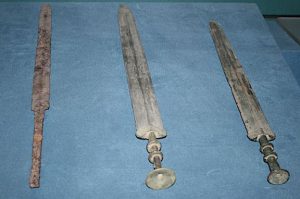
With the onset of the Warring States Period in the 5th century BCE, the level of violence was no longer contained by the hegemon system in which one land-owner was powerful enough to intimidate the others and create a kingdom or dependencies and owed favors. Nor did codes of chivalry succeed in maintaining peace. Both the purpose and conduct of warfare changed. Battles became increasingly bloody and bitter, and victory went to those kings who could field the most effective killing machines. Chariot-riding kinsmen and a few thousand foot soldiers no longer met that requirement. During the Warring States, rulers introduced large armies composed of mass infantry and cavalry. Soldiers were equipped with armor, crossbows, halberds, dagger-axes, and swords; these were manufactured from bronze, iron, leather, and wood in royal workshops located at capital cities. Kings also militarized landscapes by building forts at strategically critical passes, walls to mark off boundaries and watch towers to signal the enemy’s approach.
These rulers no longer relied solely on close kinsmen to wage war alongside them. Rather, they created a class of military commanders and specialists whose promotion was based on their ability to produce victories in the field. It is therefore not surprising that during this time some of China’s greatest military treatises were written, most notably The Art of War by Master Sun [sue-in], also referred to as Sunzi or Sun Tzu. Master Sun was a military commander and strategist who served the lords of the state of Wu just prior to the onset of the Warring States Period (c. 5th century BCE). The manual of military strategy and tactics attributed to him stresses the importance of formulating a strategy that ensures victory prior to any campaigning. Stratagem is critical. “All warfare is deception,” Master Sun states. “Hence, when able to attack, we must seem unable; when using our forces, we must seem inactive; when we are near, we must make the enemy believe we are far away; when far away, we must make him believe we are near” (Sunzi n.d.).
Over the next 250 years, during the Warring States Period, these states averaged one major battle per year until, at the very end, only one remained standing. That was the state of Qin. The Warring States period ended in 221 BCE when the Qin ruler defeated the remaining states and unified the former Zhou realm, initiating a new period in China’s history. While the era of Warring States was a crisis period, it also provoked intense intellectual and philosophical responses. Ideologies focused on addressing how to create a stable, peaceful order in China that would not degenerate into civil war and instability. Numerous political, philosophical, and religious ideas emerged in answer to this question producing the ‘hundred schools of thought’.
Reading the Past – Sun Tzu, The Art of War.
Read: The Art of War, Sun Tzu; “Section II: Waging War”, translated by Lionel Giles, 1910
Link: https://sites.ualberta.ca/~enoch/Readings/The_Art_Of_War.pdf
Legalism
Burgeoning turmoil inspired much thinking about what was needed to restore order and create a good society, as well as what defined the good life. Two major philosophical traditions emerged to address these issues: Confucianism and Daoism. In addition, Legalism emerged as a governing ideology, based on a core belief that political and social disorder occurs because humans are by their very nature cruel, violent, and untrustworthy. Legalists believed the only way to maintain order was to create and maintain a powerful authoritarian, repressive government. Peace could only be maintained if subjects were obedient, and cowed by harsh laws and brutal punishments. No critical voices or alternative ideas were allowed to challenge the authority of the state. Put more bluntly, people were not to be trusted and should be kept fearful, ignorant, and obedient. Only a powerful state led by informed Legalists could maintain a degree of order and harmony. In the coming centuries, Legalism, Confucianism, and Daoism would all play important roles in the continued evolution of the Chinese state and society.
Reading the Past – Dao De Jing (Excerpts)
Read: The Dao De Jing, Stanzas #2 and # 3, Sources of Chinese Tradition, compiled by Wm. Theodore de Bary and Irene Bloom, 1999
Link: http://afe.easia.columbia.edu/ps/cup/laozi_daodejing.pdf
Confucianism and Daoism were both responses to the crisis presented by the breakdown of the Zhou feudal order and escalating warfare in China. But of all the Chinese philosophies and ideologies born out of this age of turmoil, none had the impact or longevity of Confucianism. It is impossible to understand the continuity of Chinese civilization without appreciating the core ideas of Confucius and the influence Confucianism had on Chinese culture and politics.
CONFUCIUS AND CONFUCIANISM
Confucius lived just prior to the Warring States Period (551-479 BCE). What little we know about his life comes primarily from The Analects, a record of conversations Confucius held with his students, compiled after he died. The Analects not only shows a serious and learned man, but also someone skilled in archery and horsemanship, who loved music and ritual, and who untiringly traveled the feudal states in the hopes of serving in a lord’s retinue. According to one passage, a lord once asked one of Confucius’s students about his master, but the student fell silent. Later, Confucius asked him, “Why did you not say: As a man, when agitated in thought he forgets to eat, joyfully forgetting his cares, not realizing that old age is near at hand?” (Confucius n.d.)
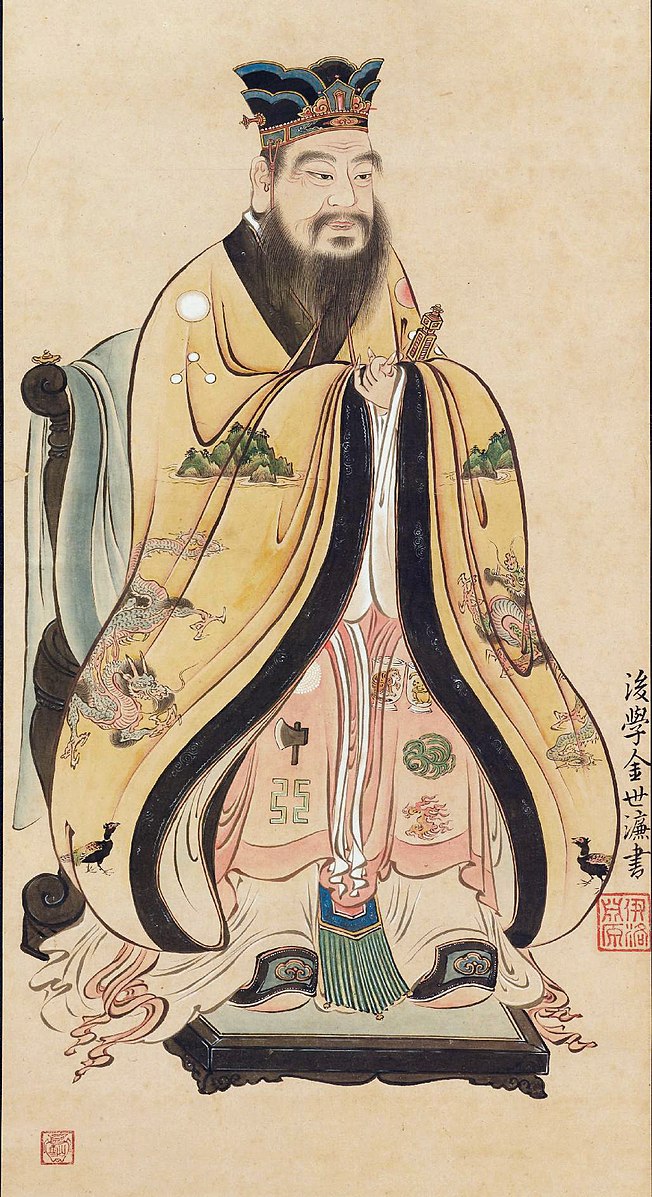
Confucius was born to a family of minor nobility and modest means in the feudal state of Lu. His father died about the time Confucius was born, and he was raised by his mother, who also passed away when Confucius was young. Like other young men of a similar background, he had access to an education and could aspire to serve in some capacity in a feudal state, perhaps at the lord’s court, or as an official or soldier. Confucius chose to become learned and seek office. To his mind, he was living at a time when civilization was collapsing and society was decaying. He believed that, during the early Zhou, the nobility was honorable, observed moral codes, and upheld social standards. Confucius looked back to the past, to rulers he saw as successful in periods he believed had been peaceful and prosperous. These included the great early Zhou Rulers Yao, Shun, and the Duke of Zhou. These men were already legends with nearly divine status. Confucius taught they had been successful because they ruled according to moral principles. If a ruler cares for the people, leads by showing an example of moral uprightness, and is humane in governing, according to Confucius, this ruler will be successful, and China will prosper.
He believed that a golden age existed in the past and wished to transmit the ethical values of that time. However, in the course of doing so, he reinterpreted the past and imbued the virtues he stressed with rich, new meanings. Here are a few of the important statements Confucius made, and what they meant: “The noble person is concerned with rightness, the small person is concerned with profit” (Confucius n.d., 4.16). Confucius redefined the meaning of nobility. For him, nobility was defined not by birth but rather by character and conduct. A truly noble person is one who puts what is right before personal gain and the desire for wealth and fame.
“Young men should be filial at home and respectful to their elders when away from home. (Confucius n.d., 1.6). Filial piety is central to Confucius’s thought. He taught how a person becomes moral because a good society only develops when composed of and led by virtuous people. He saw the practice of morality in the family as the root. Should a young man learn to be respectful and reverent towards parents and elders, he will become a humane person, and humane people are far more likely to contribute in a positive way to society.
“The noble man does not abandon humaneness for so much as the space of a meal” (Confucius n.d., 4.5). For Confucius, the highest virtue is humanity, and many of his conversations center upon defining what it is that makes a person humane. A person of humanity is, for instance, one who is capable of empathy and unselfish concern for the welfare of others. They know the golden rule: “what you would not want for yourself,” he taught, “do not do to others” (Confucius n.d., 15.23). Confucius emphasized that a society cannot function if people are incapable of taking other’s perspectives and doing their best for them. In addition, he insisted that such virtues as humanity are most fully demonstrated when individuals observe good etiquette. Decorum was important to Confucius.
“Heaven has given birth to the virtue that is in me” (Confucius n.d., 7.22). Interpreters of Confucius have rightly noted that he is quite silent about the supernatural and what happens after death, instead emphasizing the life we have and serving others. Yet, it would be wrong to conclude that he wasn’t religious in any sense because he frequently spoke of Heaven. He believed that Heaven ordains a certain course of life for each individual, including becoming a moral person. This Heaven, however, is less a deity than a higher moral order, a kind of beneficent presence.
“To govern is to rectify. If you lead the people by being rectified yourself, who will dare not be rectified?” (Confucius n.d., 12.17) Confucius believed that good governing flows from good men. The first qualification for a ruler or one who serves is moral rectitude. If those who lead do so by virtue and conduct themselves according to rules of propriety, people will learn from them and develop a sense of honor and shame. Consequently, society will become more orderly.
A key Confucian teaching was that all human relationships should be based on traditionally based duties, obligations, and rites and rituals. If both parties in any social relationship know what is expected through education and socialization, and both parties perform their obligations and duties properly, social harmony is achieved. A critical family relationship in the eyes of Confucian adherents was that between father and son. Both parties in this relationship have traditionally-based obligations to each other. While society is made up of multiple different, intersecting relationships, Confucianism identified five primary (or Cardinal) relationships that anchored society and were at the hub of community functioning. These were: father and son; husband and wife; older brother and younger brother; friend and friend (neighbor to neighbor) and ruler and ruled. Each of these relationships entails established obligations and expectations to be met; if duties are fulfilled, there is harmony between the parties. The first three Cardinal Relationships are within the family: father to son; husband to wife; and older brother to younger brother. The final two Cardinal Relationships extended the ideal of traditional duties and expectations to the society at large. Ruler to ruled reflected the political relationship between the individual and government. Friend to friend represented the social bonds making up community relationships. In all these relationships there were (and are) time-honored duties to maintain. If traditional patterns were maintained, harmony was achieved.
Confucianism emphasized a person has several different relationships which make up their social life. If a society could properly educate its citizens, if everyone were socialized to know and adhere to established, traditional patterns of social interaction in all relationships, citizens would behave in a humane manner and society could achieve harmony, stability, and virtue. This description coveys this Confucian ideal:
When the perfect order prevails, the world is like a home shared by all. Virtuous and worthy men are elected to public office…All men love and respect their own parents and children, as well as the parents and children of others. There is caring for the old; there are jobs for the adults; there are nourishment and education for the children. There is a means of support for the widows and the widowers; for all who find themselves alone in the world; and for the disabled…. Intrigues and conniving for ill gain are unknown. Villains such as thieves and robbers do not exist. The door to every home need never be locked and bolted by day or night. These are the characteristics of an ideal world, the commonwealth state” (The Record of Rites, Book IX).
The noble person, filial piety, humaneness, etiquette, Heaven, and government by men of virtue are just some of the ideas Confucius discussed as he traveled the feudal states seeking to advise their lords. However, he only managed to hold some minor offices in Lu and generally failed in his political aspirations. Instead, he gained an avid following of 70 students, whom he accepted regardless of their social status. After he died, they passed on his teachings, and a school of thought emerged from his teachings known as Confucianism. Those who belonged to it are Confucians – individuals distinguished by their commitment to the ideas articulated by Confucius, classical learning, and the value they place on character and conduct as the key to a good society and political order.
Reading the Past – Confucius: The Analects (Excerpts)
Read: Confucius The Analects, excerpts from Reading About the World, Volume 1, editors: Paul Brians, Mary Gallwey, Douglas Hughes, Azfar Hussain, Richard, law, Michael Myers, Michael Neville, Roger Schlesinger, Alic Spitzer and Susan Swan
PHILOSOPHICAL AND INSTITUTIONAL DAOISM
The Warring States period also gave rise to the emergence of Daoism. These Daoists largely rejected Confucian ideas about human moral development and social order as artificial constructs. Rather, they pointed to a natural condition that both individuals and society can regain, one that existed before desires trapped people in a world of strife. Their central concept is the Dao (“Way”). The Dao is mysterious: it is beyond sense perception and yet is the source of life and the universe, the ultimate truth transcending the polarities that make up life and yet pervades them, empty and yet the mother of all things. Paradoxically, although the Dao is indescribable and can’t be seen or heard, the goal of the Daoist is to accord with and follow it. The Dao is seen as an eternal force moving and shaping all events in the universe. In the words of the Dao De Jing “The relation of the Tao to all the world is like that of the great rivers and seas to the streams from the valleys” (Laozi, n.d.).
To be in tune with the Dao means reaching a state of spiritual integration between the individual and a universal flow of events and forces; this is how one achieves balance and serenity. But this goal cannot be accomplished through more seeking and more knowledge. Rather, the mind must be emptied out, calmed, and purified, until desires are absent and a primordial, natural condition is restored. At that point, when the individual is in accord with the ineffable Way, life becomes spontaneous, natural, and effortless.
The two most important early books belonging to this tradition are named after their putative authors: The Laozi (“Old Master”) and Zhuangzi (“Master Zhuang”). Historians believe the “Old Master” was a fictional sage invented by Warring States Period philosophers who compiled the book attributed to him. Master Zhuang, however, lived during the 4th century BCE.
In later centuries, the Daoism of these early philosophers was taken in new directions. The definition of the Way was broadened to include the idea that individuals have a spiritual essence in need of harmonizing and liberation. By so doing, it was believed, one’s health would be preserved and life prolonged. Daoists even entertained the idea that one could become immortal. To achieve these goals, techniques were developed, including special dietary regimens, yoga, Chinese boxing, meditation, and alchemy.
THE QIN DYNASTY AND THE TRANSITION FROM ANCIENT TO IMPERIAL CHINA
By 256, the Zhou were no longer legitimately in charge of their empire, and the civil wars were at their zenith. During this period, a young ruler appeared in a North Western province of the former Zhou empire who would lead his people to conquer the eastern part of the Asian continent under the leadership of the Qin Dynasty, giving it the name it has held since then: the land of the Qin (Ch’in) – China.
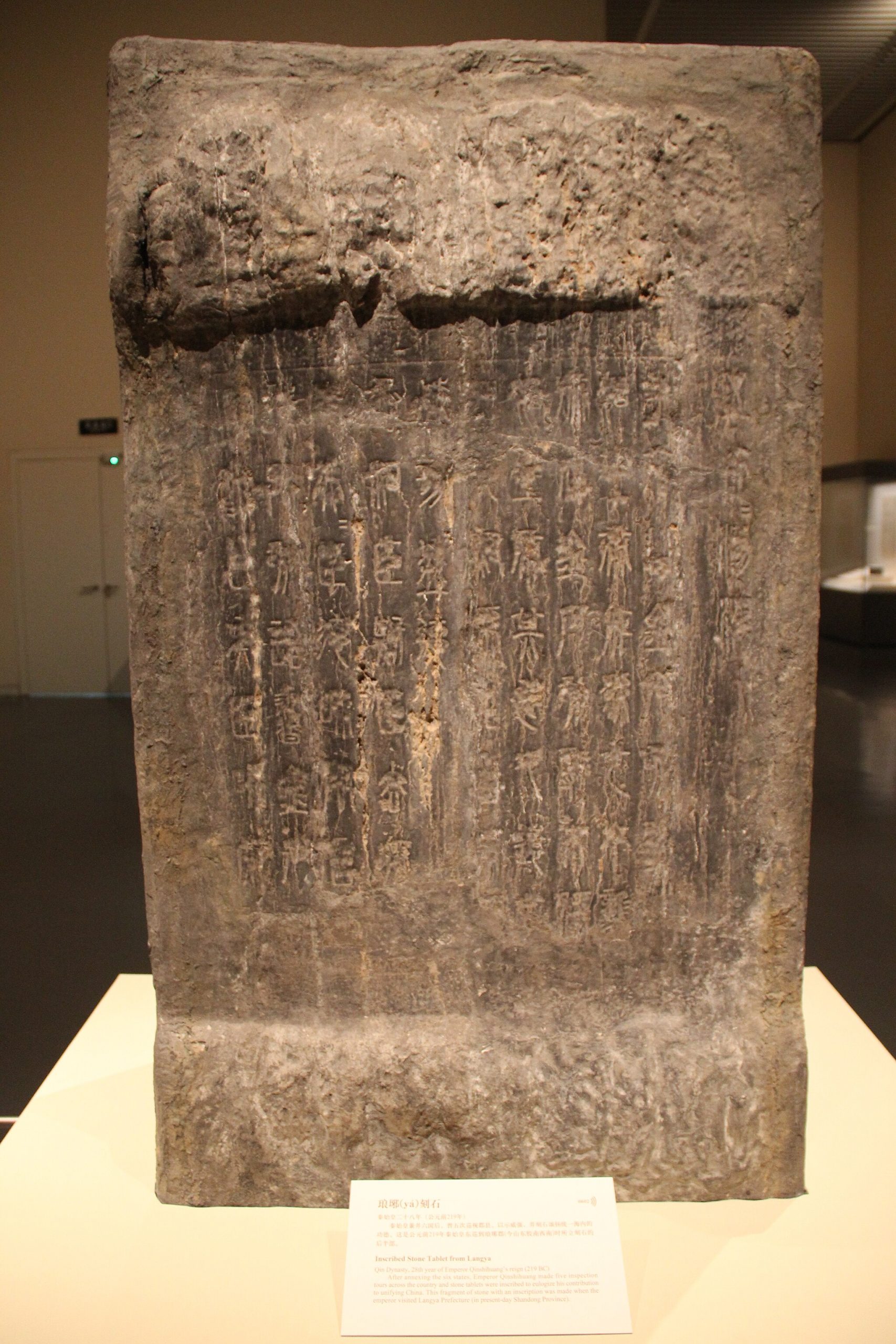
In 219 BCE, while touring his realm, the First Emperor of Qin (259 – 210 BCE) erected a stone tablet atop a mountain with an inscription proclaiming:
They [the Qin ministers] recall and contemplate the times of chaos: When [regional lords] apportioned the land, established their states, And thus unfolded the pattern of struggle.
Attacks and campaigns were daily waged;
They shed their blood in the open countryside. . . .
Now today, the August Emperor has unified All-under-Heaven into one family—
Warfare will not arise again!
Disaster and harm are exterminated and erased,
The black-headed people live in peace and stability, benefits and blessings are lasting
and enduring.
(adapted from Pines 2014)
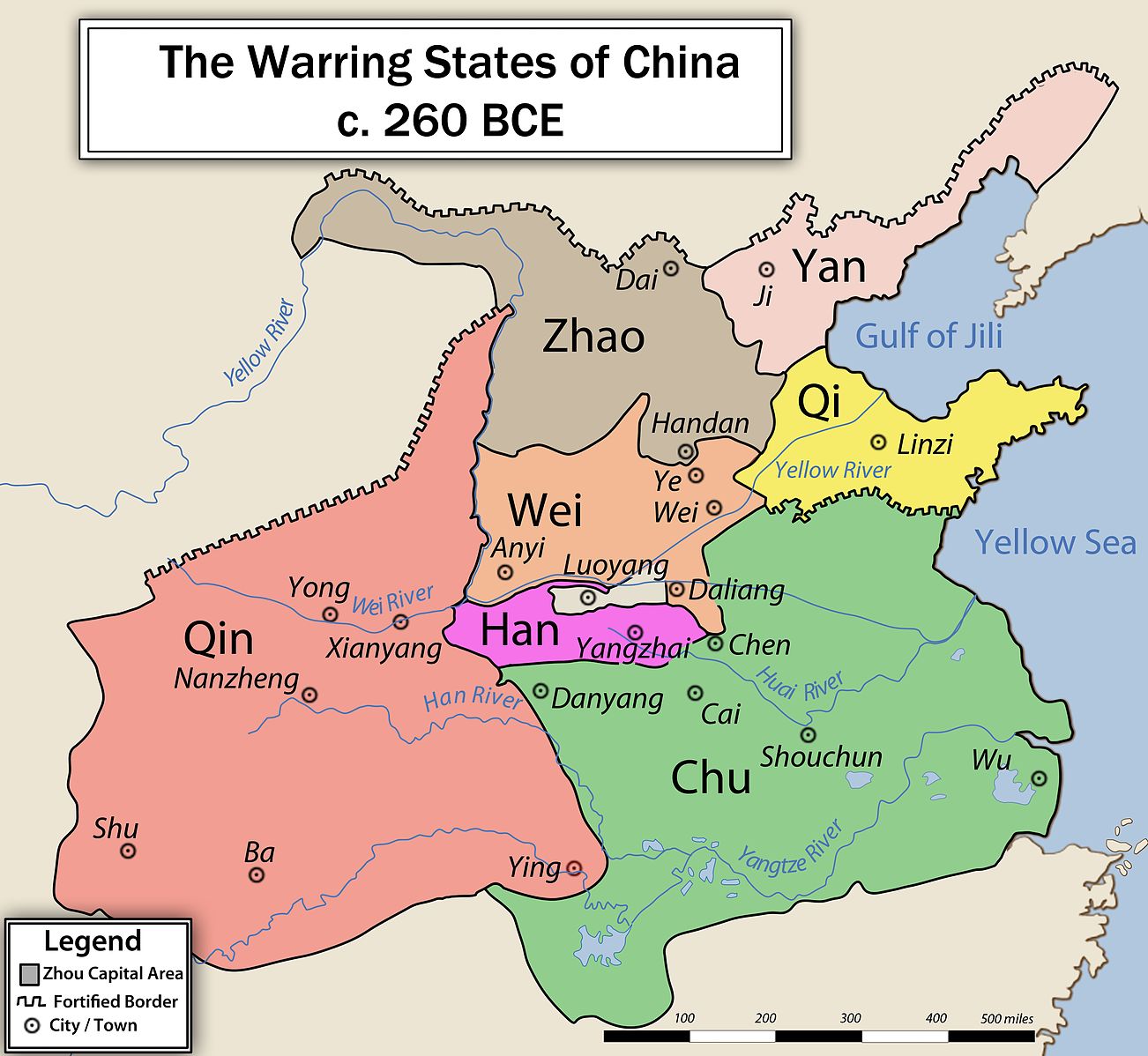
Indeed, just two years prior, in 221 BCE, the First Emperor brought the Warring States Period to a close by defeating the last remaining state. He had realized the aspirations held by the many rulers he subjugated, to unify the known world under one powerful monarch and, by so doing, initiate an age of peace and prosperity, one rooted in obedience to a sagely ruler.
The title “First Emperor of Qin,” was assumed by this conqueror only in the wake of his final victory, and it made sense. Having crushed the many warring kingdoms, the First Emperor did indeed create something new and significant: an immense territorial state centrally administered from his capital by a monarch with unchallenged sovereignty. So how did his state – the Qin kingdom – prevail?
When the First Emperor inherited the Qin throne at the age of 13 in 246 BCE, he became King Zheng [jung], young ruler of the most powerful of the seven remaining Warring States. The Dukes of Qin were important players throughout the centuries of warfare and alliances so characteristic of the Eastern Zhou, and especially after the reforms of Duke Xiao [she-ow] (r. 361–338 BCE). These reforms were based on the advice of his chancellor Shang Yang [shawng yawng], an individual famed for being one of the founders of another major intellectual tradition that developed during the Warring States Period: Legalism. The Legalists supported the efforts rulers were putting forth to strengthen their states. Their goal was to devise the best techniques for organizing a state’s territory and people so as to maximize a ruler’s power and control in times of both war and peace. Legalists believed that the best way to do so was to concentrate authority in one central administration governed by an absolute monarch.
To make this more effective, the Qin state developed a legal code with clear lists of penalties for specific crimes, made it publicly available, and applied it uniformly to people regardless of their social status. The Qin was among the most effective in establishing a civil service and county system to administer the law. Qin subjects lived under a regime with a transparent set of expectations, and also a system of rewards and punishments. Such rationality in creating an efficiently organized state through the uniform application of laws and regularizing administration, as implemented by Shang Yang, were a mark of Legalist methods.
By 246 BCE, Qin Shihuangdi was just starting on the military path that would carry him to the throne of China. Nearly surrounded in the Northwest by the Xiongnu (Hsiung-nu) and other nomadic tribes, the Qin had become very good fighters. They adopted the nomadic methods of fighting, relying heavily on cavalry and mobile, unpredictable assaults, while most other states in China relied on foot soldiers armed largely with hand-to-hand weapons. The nomadic method of warfare also relied on a kind of stand-off combat in which compound bows were used to hit the enemy as far away as 1000 feet, with opposing foot soldiers serving as ready targets for the Xiongnu [she-ong-new] bowmen. This method of warfare adopted by Qin forces was successful against the Xiongnu themselves, preserving the Qin state, and proved devastating against the armies of Qin Shihuangdi’s competitors for power in the central kingdom.
By 230 BCE, only six other Warring States remained. This was a bloody time, as one state after another fell. By 221 BCE, the Chinese realm was unified under Qin rule. Relying on Legalist tactics, the Qin state forcibly ended the Era of Warring States in 221 BCE through brutal military dominance. The Qin king claimed the Mandate of Heaven and initiated a new dynasty. This Qin leadership created, for the first time, a framework of a truly unified state achieved through the force and control of Legalist tactics.
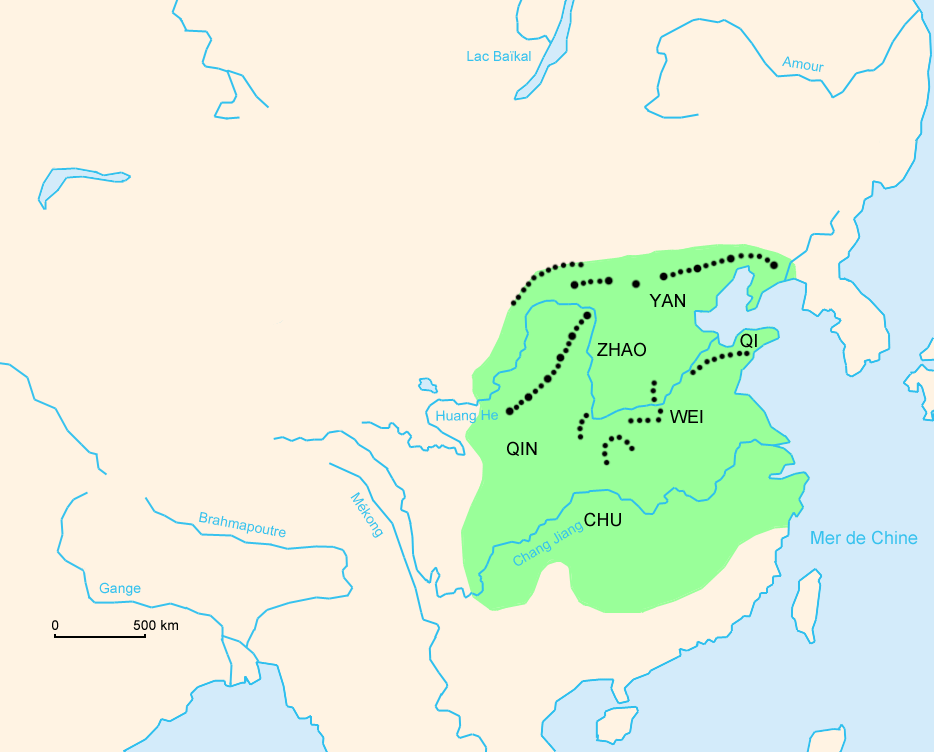
While earlier Xia, Shang, and Zhou states were built on feudal relationships, the Qin created the first centralized state in which there was only one unquestioned power, that of the emperor. The first Qin emperor followed the same policies that had successfully unified his own territory prior to the conquering of the empire, These had proven their worth by making the Qin state both stable and powerful.
Although the Qin Dynasty (221–207 BCE) was short-lived, it had a lasting effect on China because of the stable administrative foundation it laid. The First Emperor of Qin and his advisors invented the imperial title used by all subsequent rulers. Once he had consolidated his hold on states of the Yellow River basin – the “civilized” north of China – Qin Shihuangdi immediately set out on a series of wars of conquest. These wars brought under his power the area of the Yangtze River in the south – the rice basket of China – and the area north of what is now Vietnam, penetrating at one point all the way to the Red River.
In the north, Shihuangdi had his people connect and expand on the walls that Zhou era states had built along their borders to protect against invasion by the Xiongnu and other nomadic steppe tribes. This, the first “Great Wall of China”, eventually ran for 1400 miles. Its building was accomplished through the corvee, the same labor tax used to tame the Yellow River. The building of this wall was an arduous, difficult process fraught with the danger of injury or death by construction accident, or death in a raid by the nomadic tribesmen it was meant to keep out. At tremendous cost, both human and financial – the building of the wall may have cost up to one million lives – the wall was completed before 206 BCE.

The Qin Emperor also consolidated his power internally by creating a powerful, centralized government that had control of all aspects of Chinese society. One of Qin’s most important reforms, carried out by his Prime Minister, legalist philosopher Li Si, was to bring all former aristocrats and territorial kings into the capital city, Xian. These kings and aristocrats forfeited their land to the emperor and were given lavish palaces just across the Yellow River from the imperial palace, designed to be grand and tremendously large to impress upon those who viewed it the phenomenal power of the emperor to command labor and capital in China. Once the land was firmly in the emperor’s hands, Li Ssu divided the empire into forty prefectures, each of which was subdivided into counties. The officials of the counties were responsible to the prefecture governors, who were, in turn, responsible to the ministries of the central government, and those ministries were, in their turn, responsible directly to the emperor himself. There was a clear devolution of power from the center to the periphery – all authority came directly and in a straight line from the emperor himself. Governmental organization was extremely efficient, minimally corrupt, and committed to serving the emperor. It also meant every family in China, no matter how rich or poor, was subject to taxation, which provided a tremendous revenue stream, allowing the accomplishment of many of the reforms to follow. With an expanded centralized military force, First Emperor carried out military campaigns that created the basis of the expanding and long-lasting Chinese empire. Later Emperors successfully continued this imperial march across parts of Asia, expansion made possible by a centralized military force. The bureaucratic framework for a mighty state was established under Qin leadership and these tools of power were wielded by all later Emperors.
Further methods of centralizing the power and authority of the Qin emperor included creating a network of roads that centered on his capital in Xian. Over 6800 kilometers of road were laid to connect the capital at Xianyang to each province and the northern border. The creation of transportation and communication routes made Xian the geographical as well as political center of the Chinese world. This encouraged those within the empire to think of Xian in terms of a center and themselves as subjects of it.
Shihuangdi also decreed standard measurements for weight, distance, time, and money, so that trade could flourish. The richer the merchants, the richer the mercenary government that taxed them. He made all cart axles a certain width, and built roads according to the measurements of those carts. All of these measures served to facilitate communication, travel, and commerce across the land and, therefore, political stability and cultural unification. As a symbol of his power, the First Emperor also constructed an imposing palace and mausoleum. For all these reasons, historians mark Qin unification as the beginning of China’s imperial era.
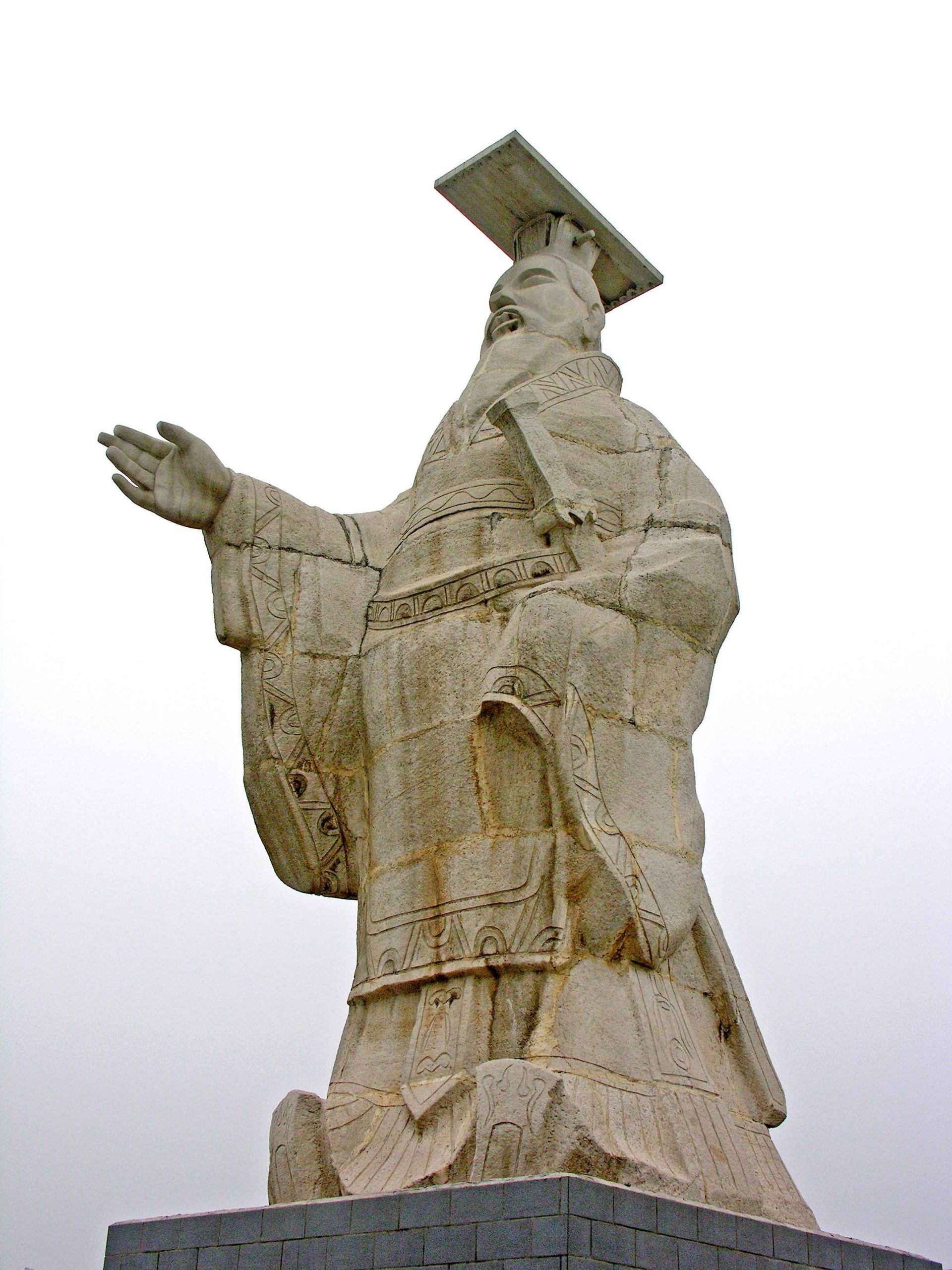
In perhaps one of the most far-reaching reforms, Shihuangdi standardized the Chinese system of writing, the Chinese characters, many of which were written in very different styles or with very different meanings, depending on the local area. This standardization worked remarkably well. It created a unified literary language that most educated Chinese took as their written language, thus creating a standardized system for communicating ideas. This written language enabled the leadership, and later rulers, to communicate across local dialects and diverse regional writing systems.
The cost of all of this centralization was that, due to its Legalist leanings, the government of the Qin was intolerant of other ideas. Books on Confucianism, the Dao, and other ideas that had found their expression during the period of wars, were burned. The burning of books, combined with several other measures including high taxation and severe punishments for even the lightest of crimes, eroded public goodwill. By 210 BCE, when the first Qin emperor died there was a restive atmosphere in China. At the same time, the son of Qin Shihuangdi was not the man his father had been. He was unable to secure the respect and obedience of his advisors, commanders and administrators in the way that his father had. The empire began to fall apart under his rule. Along with that, the Legalist system meant that the state was punishing significant numbers of people with death or torture. This made it impossible to avoid uprisings. In 206 BCE, the Qin dynasty collapsed under the weight of its own Legalist repression.
The Legalist state imposed heavy tax burdens, drafted subjects into military or labor service, and enforced restrictive laws. The Qin dynasty was murderously repressive towards anyone who espoused or believed in competing ideologies or questioned obedience to this dynasty. Thus the unpopular Qin dynasty rapidly lost support of the people. Without that, and since they had rejected the idea of the Mandate of Heaven, there was no system of legitimacy in place when the rulers themselves failed. The First Emperor died in 210 BCE; by 206 BCE, the dynasty was overthrown. In the end, Legalism failed as the sole organizing principle for the state.
THE HAN DYNASTY, 202 BCE–220 CE
After the First Emperor died in 210 BCE, the Qin Empire rapidly disintegrated. Historians debate causes but highlight weak successors manipulated by the intrigues of a high minister and court eunuchs; excessive demands on the population for building projects especially tax revenues, and military conscription; and a climate of fear created by the harshly punitive legal system. By 207 BCE revolts were breaking out across the land as rebels accrued armies, seized territory, and even declared themselves kings. China then fell into a state of civil war for five years until the intervention of Liu Bang [lee-oh bawng] (d. 195 BCE) who was able to reestablish central control. By 202 BCE, the short-lived Qin Dynasty was succeeded by what became the longest-lived Chinese dynasty – the Han Dynasty. This dynasty was unique in many ways, including the fact that the founder of the dynasty, the first Han emperor (Han Kao-tsu) – originally known as Liu Bang – was not of noble birth. He was lifted from obscurity as a minor Qin official and by 206 BCE had become one of the major contestants for the throne of China. His ruthlessness and absolute ambition drove him to victory over several nobles who also wished to fill the power vacuum, and he became the progenitor of a line that would rule China (with two breaks) until 221 CE.
Government and Society during the Han Dynasty
The Han Dynasty, ruled by 24 successive emperors from the Liu imperial family, is normally divided into a Western Han (202–8 BCE) and Eastern Han (25–220 CE) because for a brief time (8 BCE-25 CE) an imperial in-law usurped the throne and established his own short-lived dynasty. This brief interregnum aside, the Han Dynasty lasted 400 years, making it second in length only to the Zhou Dynasty. So important was the Han in establishing patterns in Chinese civilization that distinguished the Chinese from those around them, that Chinese people today refer to their ethnic group as Han Chinese. Also, after adopting the foundations laid by the Qin Dynasty, the Han further strengthened them, cementing an imperial pattern that persisted in China until the fall of the last dynasty (Qing) in 1911 CE.
From the outset, the Han Dynasty inherited the Qin legalist system of government, with its emphasis on rational and efficient methods of administration and the use of systems of rewards and punishments to promote order. However, early in the Han, Confucian scholars criticized Qin governing for lacking humaneness, and Han rulers increasingly saw the benefit of using Confucian ideas to govern. This change was particularly evident with Emperor Wu [woo] (r. 141–87 BCE). During his reign, Confucius’s ideas were molded into an ideology that legitimated monarchy and hierarchical social order. This ideology is called Imperial Confucianism. As an ideology, it provided a blueprint for how the political and social order should function.
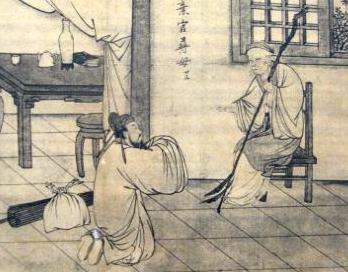
Rulers saw the benefit in having officials who were highly educated, loyal, of good character, and who understood the formalities of ritual and etiquette. An Imperial Academy was founded at the capital in 124 BCE so that students could be educated in classical Confucian texts, including The Analects. Across the country, these students were nominated by local officials based on their learnedness and virtuous conduct. Successful graduates went on to serve as officials, and, because that office conferred the highest prestige and status in Han China, Confucian values penetrated society. In addition, to deal with the vast needs of such a large kingdom, Han leaders initiated the beginnings of a civil service examination system. Many administrators were chosen this way during the Han. These examinations were very difficult, based primarily on Confucianism. Texts were compiled explaining good etiquette, conduct, and ritual requirements for each family member and members of society based on their superior or subordinate status. Filial piety was celebrated in both art and texts, and law codes reinforced social norms, for example, by supporting the authority of the family patriarch, division of property among sons, and arranged marriages. In brief, over the course of the Han Dynasty, the Chinese increasingly identified themselves as defenders of Confucian civilization.
Confucianism was made the formal ideology of the Han state. Confucian scholars taught ethics, adherence to hierarchy, proper observance of the rituals, and respect for the rules, rulers, and law. Gradually, as more and more administrators were needed in the growing empire, Confucian scholars became the answer to the problem. Formal educational instruction of Confucian classics and texts were established by 124 BC. One of the most intriguing Confucian scholars was Ban Zhao.
Reading the Past – Ban Zhao (c. 80 CE) ‘Lessons for a Woman’
Read: Lessons for a Woman, Ban Zhao, from Pan Chao: Foremost Wooman Scholar of China, translated Nancy Lee Swan, 1932
See also: World History Encyclopedia: Women in Ancient China
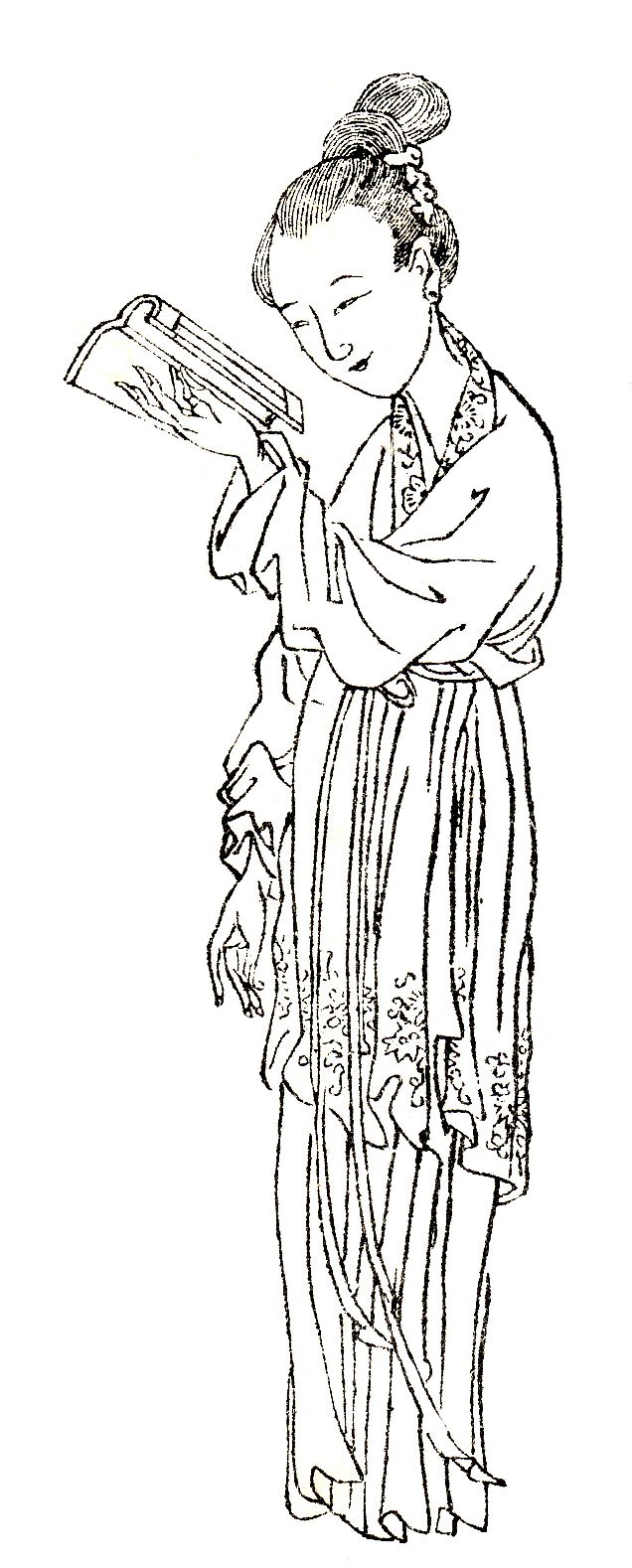
Ban Zhao was born to a family of Confucian scholars, educated with her brothers. She was married in the traditional Chinese fashion, and left her family for that of her husband, where she was expected to serve and raise and educate the children. She was apparently encouraged in her studies by her husband as well. Her brother became the imperial historian and when he died, Ban Zhao took over writing the official Han history he had undertaken. She lived in both worlds – that of traditional wife and mother, and that of the scholar-bureaucrat. She left us an interesting document that gives insight into both, Lessons for Women. In this treatise, Ban Zhao shows her high degree of education, but also showcases a view of Chinese society during the Eastern Han era. The essay espouses respect and subservience in terms of a social duty and Confucian obligations. Even the emperor had obligations; without the proper performance of these, the society would fall apart. In effect, Ban Zhao argued education teaches that each person in the world must be subservient to her or his position, including gender roles; female means one must play one’s proper role to be moral.
The emperor was at the pinnacle of both Han society and the political system, while the imperial family and in-laws constituted a privileged aristocracy. The emperor’s authority derived in theory from his having received the Mandate of Heaven, reflecting his virtue and his role as mediator between the celestial realms and human world; as such, he could expect his subjects’ obedience and loyalty. He resided within the walls of the imperial palace at the capital city, attended by eunuchs who handled his personal needs, members of the palace administration, and the imperial harem. Emperors had numerous consorts but also a principal wife – the empress – who held a special status and was quite influential, usually because she bore the heir to the throne, but also because she and her in-laws were an intimate part of the emperor’s palace life. Often, the imperial family, imperial in-laws, eunuchs, and high officials broke apart into squabbling factions fighting for power and influence; this contention had deleterious consequences for the smooth functioning of the political system.
The professional administrative structure was directly responsible to the emperor and its fingers reached throughout the empire. This allowed for efficient taxation, provision for horses and soldiers at posts throughout the empire, and local administration of law through a salaried professional officer corps. In 141 BC, Emperor Wu of Han, otherwise known as Han Wu-di, ascended to the throne of the empire. Han Wu-di was one of the most energetic and able of the Han emperors. His greatest legacy was the further centralization of the Han political structure internally and the extensive expansion of the Han empire across Central Asia, SE Asia, and Northern Asia.
Han Expansion
Strengthened by its ever more confident political system and society, Han China became an expansive empire, occupying and colonizing territory all along its borders. Sometimes this process was gradual: as migrants and merchants moved into neighboring areas, the government followed by setting up garrisons to protect them and eventually counties with civil servants to govern them. In other cases, armies were sent to subdue unstable borders or to secure trade routes. As the dominant power in the region, China’s actions profoundly influenced and shaped the history of peoples and states in neighboring areas of Central and East Asia.
Han armies expanded China’s control and influence, successfully capturing huge portions of Asia. They drove the Xiongnu (steppe nomads) back, deeper to the north of the Gobi Desert, conquered parts of northern Annam (Vietnam) and, some hypothesize, established limited contact with the forces of the other major world power of the time – the Roman Empire. Emperor Han Wudi moved the western borders of the empire to the eastern border of the Persian empire, encompassing what is now Afghanistan, Kazakhstan, and Uzbekistan, as well as the Xinjiang area that is still a part of China today. As the Persian empire crumbled, Roman and Han armies were probably within a couple of hundred miles of each other, perhaps dimly aware of each other, but they apparently never came into contact in any meaningful way.
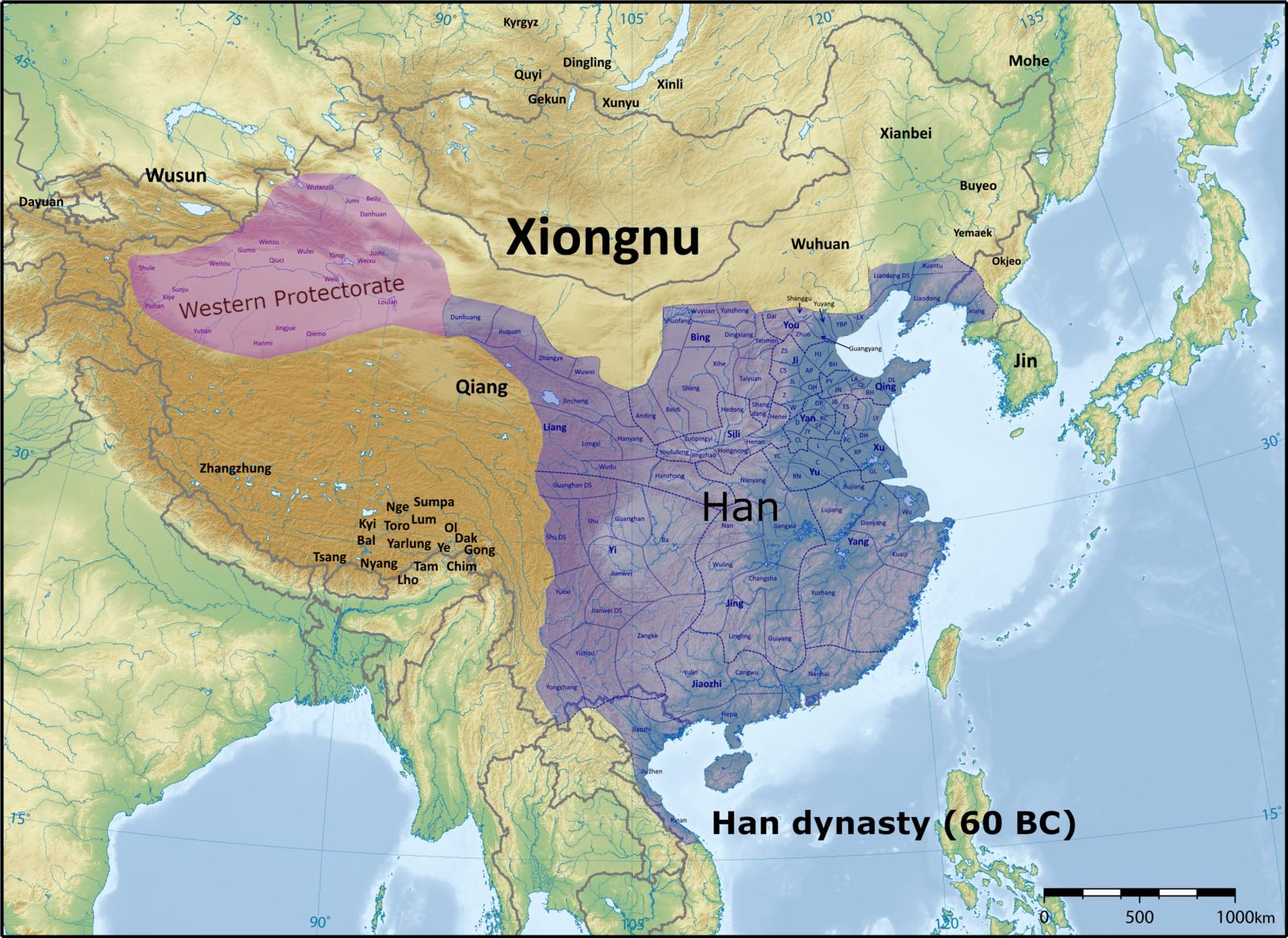
Traditionally, the biggest threats to the settled agricultural population of China came from non-Chinese nomadic pastoralists scattered about the steppe lands along the northern border. These skilled horsemen and hunters tended their herds from horseback, resided in mobile campsites made up of yurts, and organized as tribes. These tribes usually selected the most skilled male warriors as their chieftains and also periodically organized into confederations so as to raid Chinese villages and towns. During the Han Dynasty, the most threatening confederation was knit together by Xiongnu. The founding emperor, Liu Bang, had sought to subdue them with his armies but was defeated and forced to pay tribute and offer imperial princesses in marriage to their chieftains. Emperor Wu, however, enjoying a stronger government, sent massive armies of over 100,000 soldiers campaigning deep into Xiongnu territory, breaking up their confederation and forcing them to relocate. Although his armies suffered great losses, Emperor Wu established garrisons across the northern border to consolidate his gains and protect China.
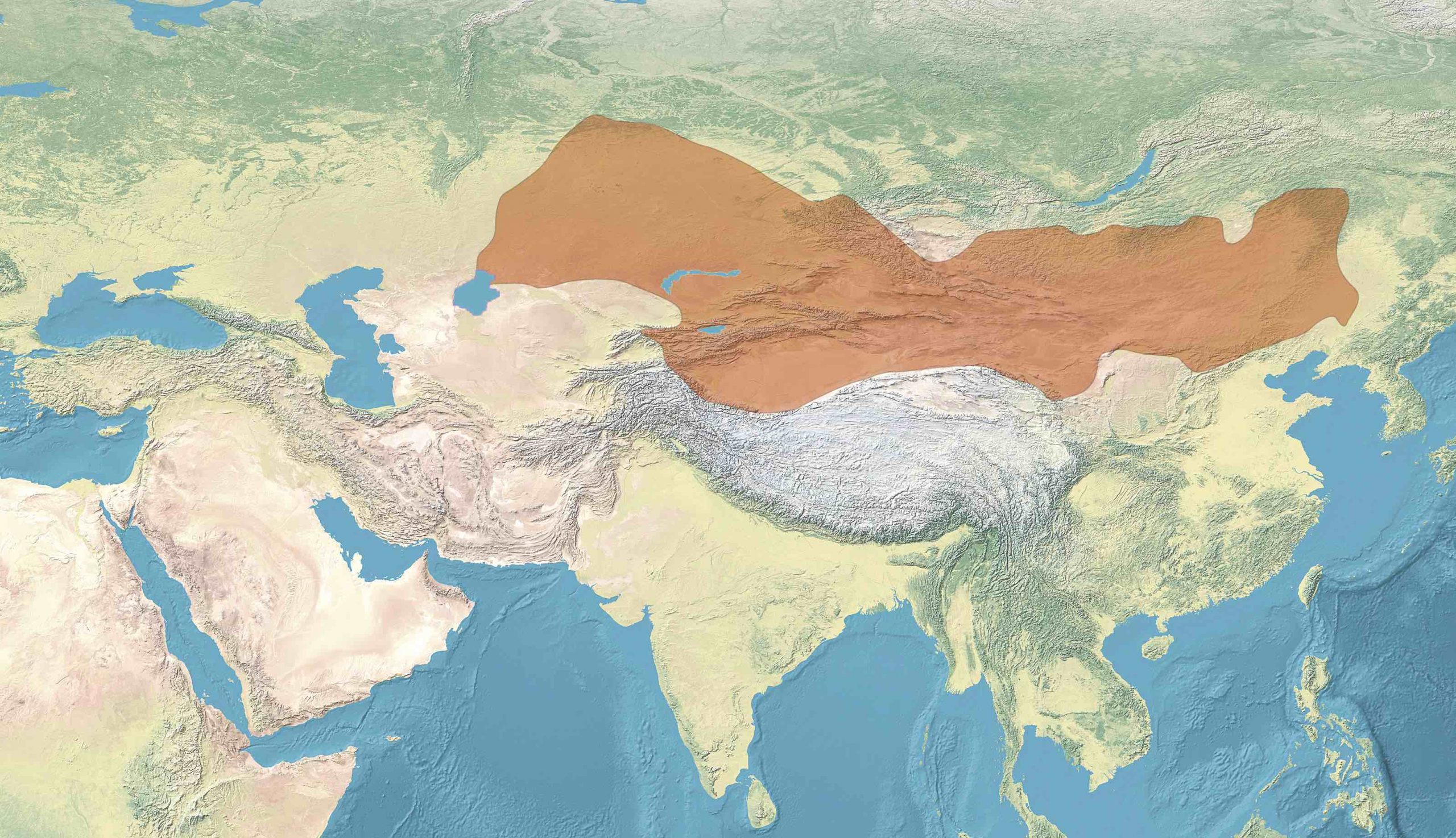
As Emperor Wu brought the Xiongnu under control, he became curious about Central Asian territories lying to the west of China. Interested in finding allies that might support him in his efforts to control nomad confederations, he sent envoys on exploratory missions. They returned with news of trade routes extending from oasis city-states ringing the forbidding deserts of the Taklamakan Desert to countries lying beyond the Pamir Mountains. What they were speaking of were the earliest links of the Silk Roads. Merchants had been using camels to carry such goods as silk from China to distant civilizations while bringing back gold, horses, and various handicrafts and foodstuffs.
For that reason, beginning in 104 BCE, Emperor Wu dispatched armies to subdue the region as far as the Pamir Mountains, making the Han Dynasty overlords to Central Asian states, which were now obligated to send tribute and hostages. A frontier network of walls and watchtowers was extended partway into the region. The Silk Roads trade networks were thus secured, and, because it could be conducted more safely, the volume of traffic grew. During the Han Dynasty, China demonstrated its intention of being a dominant player in Central Asia.
The Silk Routes
The Silk Routes (also known as the Silk Road or Roads) was a series of trade links that linked Central Asian societies, likely in partial form, early in the history of civilized societies. It was always difficult and treacherous, but prior to Indian and Chinese development of viable ocean-going vessels, there was no alternative for long distance trade. The earliest documented use of the Silk Routes dates from the period of the Han Dynasty. Emperor Wudi (140-87 BCE), known as the Martial Emperor because of his military successes, expanded control into what is now Xinjiang – the western area of China in and around the Taklimakan Desert. At the very edge of that desert, Wudi erected the Jade Gate, and finished the Great Wall at that point. The efforts and costs committed to extend the Great Wall, maintain a permanent garrison at the Jade Gate in Xinjiang, and extend a degree of protection (de facto and official) to trade caravans across the Taklimakan Desert made clear Han leaders were deeply interested in promoting trade as well as extending control into the western regions of Asia.
The Silk Routes tied together societies throughout Asia, with links to the ancient Near East and thus the Mediterranean. The two major trading partners were China and India. China supplied the world with silk, white porcelain, and other prized products. India provided nutmeg, pepper, and cotton, among other products. Trade in these commodities was, at the time, the most extensive and valuable trade in the world. The Silk Route was one of the most difficult passages in the world. Long treks over extremely harsh and dangerous terrain characterized the route for most of its history. Even today, in some sections in the Taklimakan, a caravan of camels can travel faster and farther than well prepared four-wheel drive vehicles. Along the Himalayan mountains, the Pamirs, and the Hindu Kush there are still passes that are impassable by motor vehicle. The journey was dangerous and challenging, but it was worth the risk of disease, bandits, dehydration, and worse to derive the profits from sales along the route. The journey along the Taklimakan section required that nearly 3/4 of the weight carried by a caravan was water and food due to hostility of the environment. This left precious little space for cargo which thus had to fetch a great price to make the journey profitable.
For most of its history, Central Asian territories were controlled by various groups of steppe nomads and small principalities. Many lived at least in part on revenues secured from the Silk Route trade. Those revenues came from markets in towns and cities, or cash paid to local chiefs or princes for safe passage across their section of the route. The route was usually divided by the borders and laws of various territories as goods made their way from buyer to seller – accumulating value along the way. Not until the Mongol Empire was initiated during the 13th century were the routes of the Silk Road tied together under one political authority.
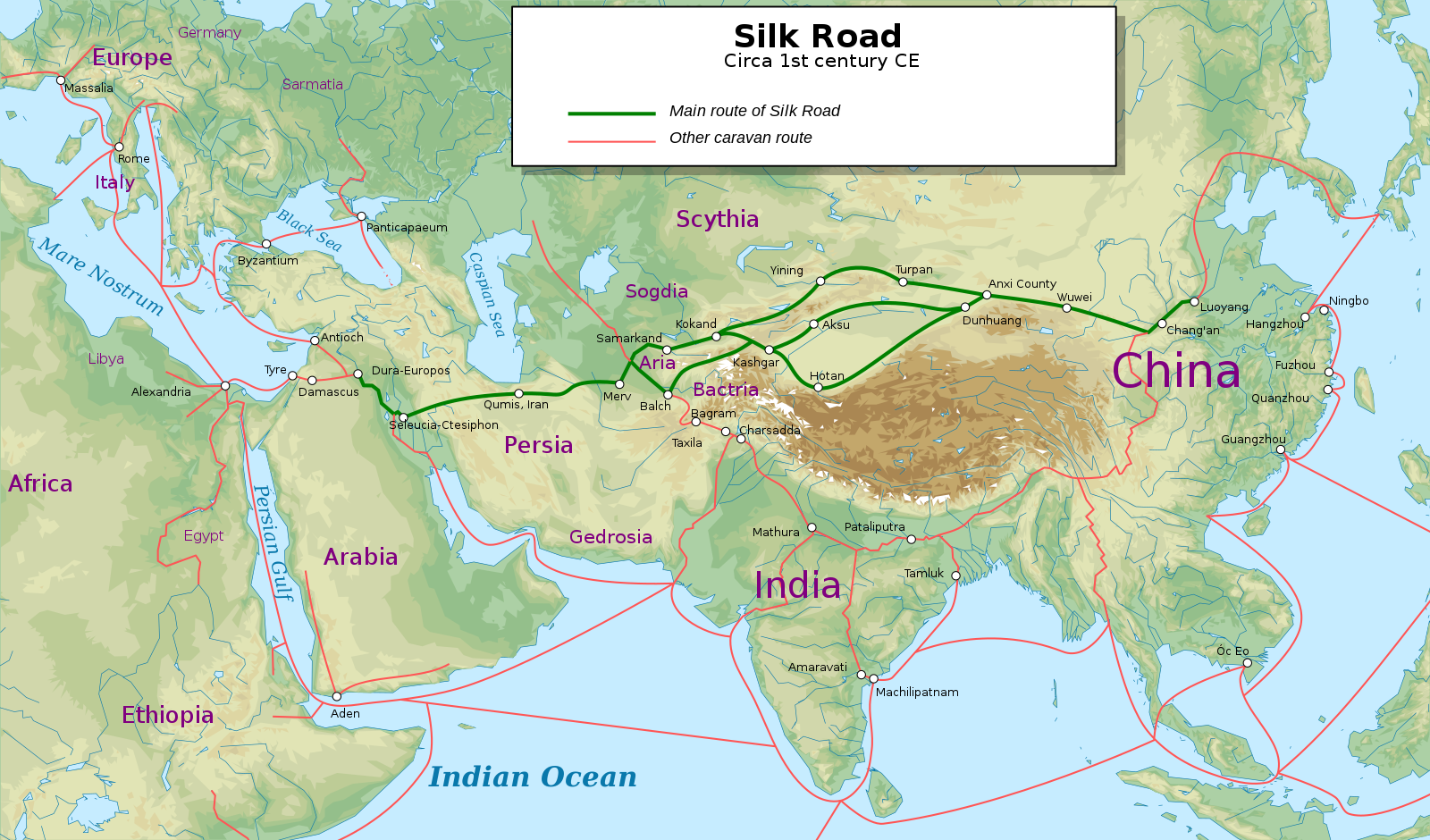
In addition to these land routes, Indian and Chinese goods also traveled by the more treacherous sea-borne routes in the South. Sea based trade was the only way pepper, one of the most expensive commodities in the world before 1488, was moved from the source, the Moluccas. The sailors along this route were from what is now Indian Mysore and from Ceylon Malaysia, Indonesian, Bali, and China. They developed sophisticated semi-triangular sails that could be turned and manipulated to help sail with the wind or to tack upwind. These sails became the basis for later Arab sail designs known as lateen sails. The dead-reckoning and star-sight navigation techniques used by these early maritime traders became models for later Arab and Chinese sailors, and eventually led to the creation of nautical maps and the development of technologies such as the magnetic compass, invented in China and quickly adopted by sailors along the southern route.
The Silk Routes and the Southern sea routes enabled exchange not just of goods, but also ideas. Due to these routes, people from China to Ceylon to Europe were able to share technologies and languages, as well as philosophical, political, and religious thought. The most important ideas to travel these routes during the Han era were Buddhist teachings. The appeal of Buddhism as it spread during the Han Empire was due to several factors. The fact it was not a Chinese ideology enabled non-Han subjects to accept Buddhism as less challenging than the cultural and historical requirements of Confucianism. It was a systematic religion offering comfort, hope, and a path to serenity in an unstable world. And as it arrived in China, Buddhism was open and accessible. Men and women could become Buddhists, and within the monastery or temple, all were equal. For women as well as the poor, it was a social equalizer, providing an equal chance for salvation. Buddhism stressed equality, kindness, charity, the value of human life and required only faith and devotion for salvation. Buddhist monasteries and temples survived off the grants of the rich who wished to find Nirvana after their deaths and so gave generously from their estates.
Learning in Action – The Silk Route
View the interactive map and click on the following key cities: Xi’an, Samarkand, Karakorum, Isfahan, Dunhuang
Link: https://en.unesco.org/silkroad/silkroad-interactive-map
FALL OF THE HAN DYNASTY and THE PERIOD OF DIVISION
Over time, Chinese Emperors had trouble paying for military adventures undertaken, and the Chinese empire came under increased attacks by Xiongnu and other nomadic groups who exploited the slightest sign of weakness. Within the borders of the empire, Xiongnu became restive and caused serious problems and expenditures. The Eastern Han found itself frequently at the mercy of barbarian raids, particularly in the north. It was in this period that the historical Hua Mulan, was active. The story of Mulan is well known from the Disney animation, though that movie is, of course, historically flawed. Mulan did exist, and she apparently did take her father’s place in the army. As the movie suggests, death was a surety if her gender was discovered, as was the law at the time. She also, apparently, performed historically remarkable feats. There are a number of conflicting versions of the Mulan story but her legendary status remains and intrigues us.
By the start of the 3rd century CE, the Han Dynasty was on an unsustainable path due to unstable finances, flawed rulers, and corrupt administrators. Chinese societies experienced the kinds of crises that presaged the end of a dynasty: starvation, deadly barbarian raids, loss of Han control over territories, and increased banditry, violence, murder, and abuse. The Han appeared to be losing its Mandate of Heaven. The collapse was inevitable and by 221 CE, the Han Dynasty was finished. China was then divided up by independent, short-lived kingdoms until 589 CE when the Sui Dynasty reunited most of the territory once controlled by the Han.
For four centuries, during what is known as the Period of Division, China was politically unstable and racked by endemic warfare. Yet, in spite of the violence, these centuries also saw vibrant cultural developments, as Buddhism became an organized institutional religion, reshaping the spiritual landscape. Within their realms, each warlord sought to strengthen his hand against competitors by restoring order and establishing a functioning state as they sought to secure fighting men and revenue. Cao Cao (155 – 220 CE) was the most effective in achieving these goals. He was the adopted son of a Han court eunuch and eventually entered the military. As a commander, he earned his spurs leading Han armies against a rebel group known as the Yellow Turbans. As the dynasty fell apart, he gained control over it and established a dictatorship in northern China. It was his son who removed the last Han ruler and established the Wei [way] Dynasty (220 – 265 CE), one of the Three Kingdoms.
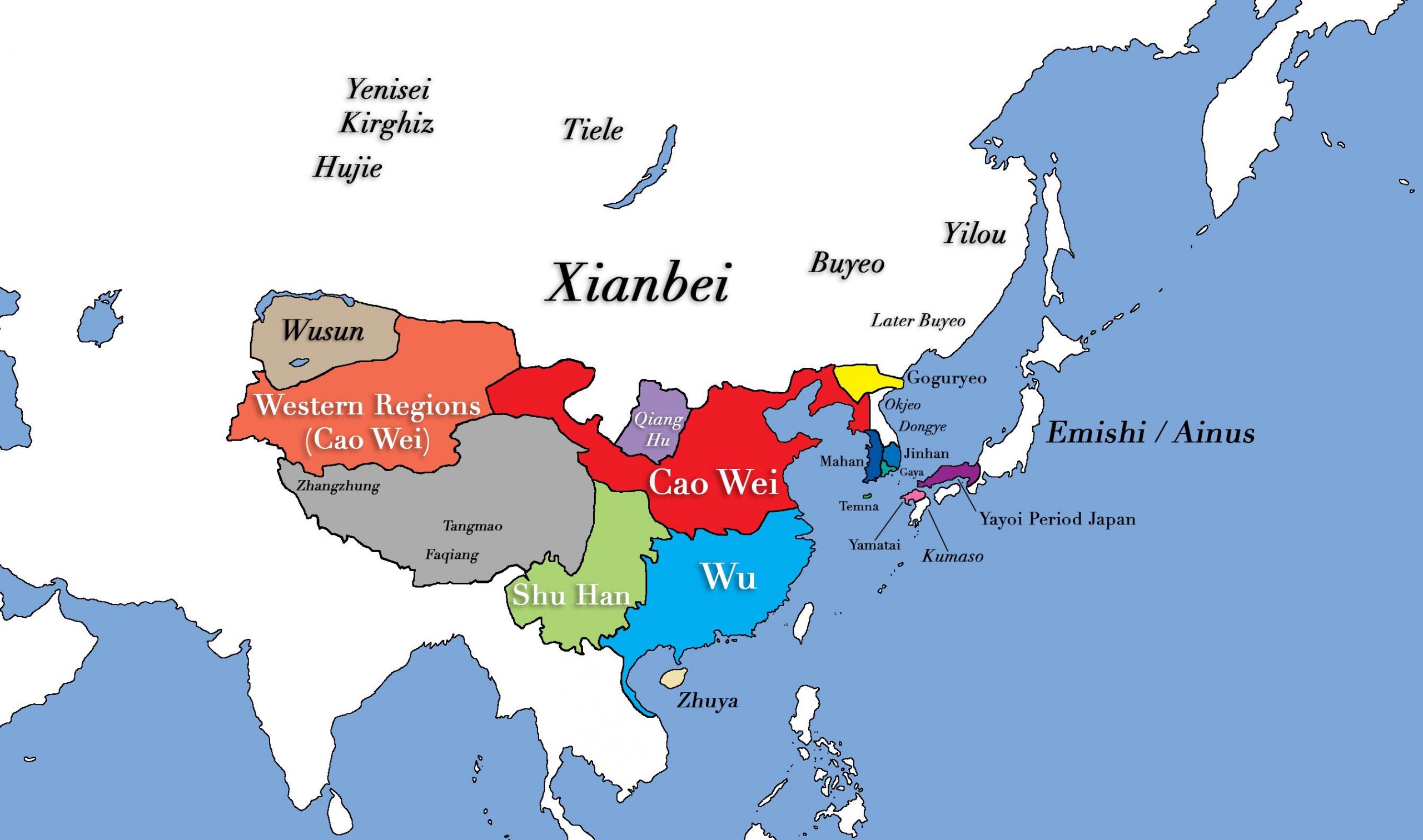
By this time, as a result of the rebellions and civil wars, much land in north China had gone to waste. So Cao Cao turned it into huge state farms where he could settle his soldiers, landless poor, and, most importantly, tribes of nomadic herders from the steppe lands to the far north who had served him as he came to power. Thus, Cao rulers created colonies of farmers who supplied tax revenue and, as hereditary military families, soldiers for Wei armies. Such state-owned land and hereditary soldiers became the mainstays of warlord dynasties throughout this time.
The two other kingdoms, Wu and Han, were located in the south. Over the course of decades, the ruling warlords of all three states fought each other in campaigns involving much treachery and stratagem. In 263 CE, the Han kingdom fell to the invading forces of Wei commanders. But then, just two years later, a powerful Wei family – the Sima – usurped the throne and changed the kingdom’s name to Western Jin [jean] (265–317 CE). The Western Jin conquered Wu in 280 CE, thereby bringing to an end the Three Kingdoms period.
The Western Jin reunified China, but that unity wasn’t to last. The policy of settling tribes of non-Chinese nomads in north China backfired. Among them, rebel chieftains rose up, carved out kingdoms of their own, and expanded their power all across the north. One Xiongnu chieftain, Liu Yuan [lee-oh you-anne], even declared he was a descendant of a Han Dynasty imperial princess and therefore had the right to restore the Han Empire. His son descended on the Western Jin court at Luoyang and eventually, in 317 CE, forced it to flee east to Jiankang [jee-an cawng] (today’s city of Nanjing).
China was again divided up among competing dynasties, a state of affairs that would persist until 589 CE, a time referred to as the Northern and Southern Dynasties (317–589). Six successive Southern Dynasties were all located at Jiankang and had as their base of power the Yangzi River basin. But their rulers were usually militarily weak and lacked revenue due to southern China’s status as a colonial frontier, dominated by powerful families with large estates and private armies. These families highly valued their pedigrees, intermarried, and saw themselves as the heirs to Confucian civilization. At the southern court, they dominated high offices, thus constituting a hereditary aristocracy. The ruling family was always limited in power by their influence.
The situation was even more complex in the north during those three centuries. The kingdom established by Liu Yuan along the Yellow River was just one of numerous short-lived Northern Dynasties established by non-Chinese chieftains of different ethnicities. The Liu rulers, for instance, were Hsiung-nu, while others were of Turkic ancestry. At times, the North was divided among numerous, rival regimes, while, at others, it was unified. But all of these kingdoms shared similar characteristics. They were ruled by military dynasts who wanted to restore the Chinese empire. Their armies consisted of an elite, heavily armored cavalry drawn from aristocratic military families that was supplemented by Chinese foot soldiers. They employed educated Chinese to serve as civil officials and administer their territories.
The Northern and Southern Dynasties came to an end in 589 CE after Yang Jian [yawng gee- an], a general hailing from the ruling clan of a northern kingdom, first established control over all of North China and then defeated the last Southern dynasty. He ruled his new Sui [sway] Dynasty as Emperor Wen [one]. China was once again united under one dynasty.
ESTABLISHMENT OF BUDDHISM
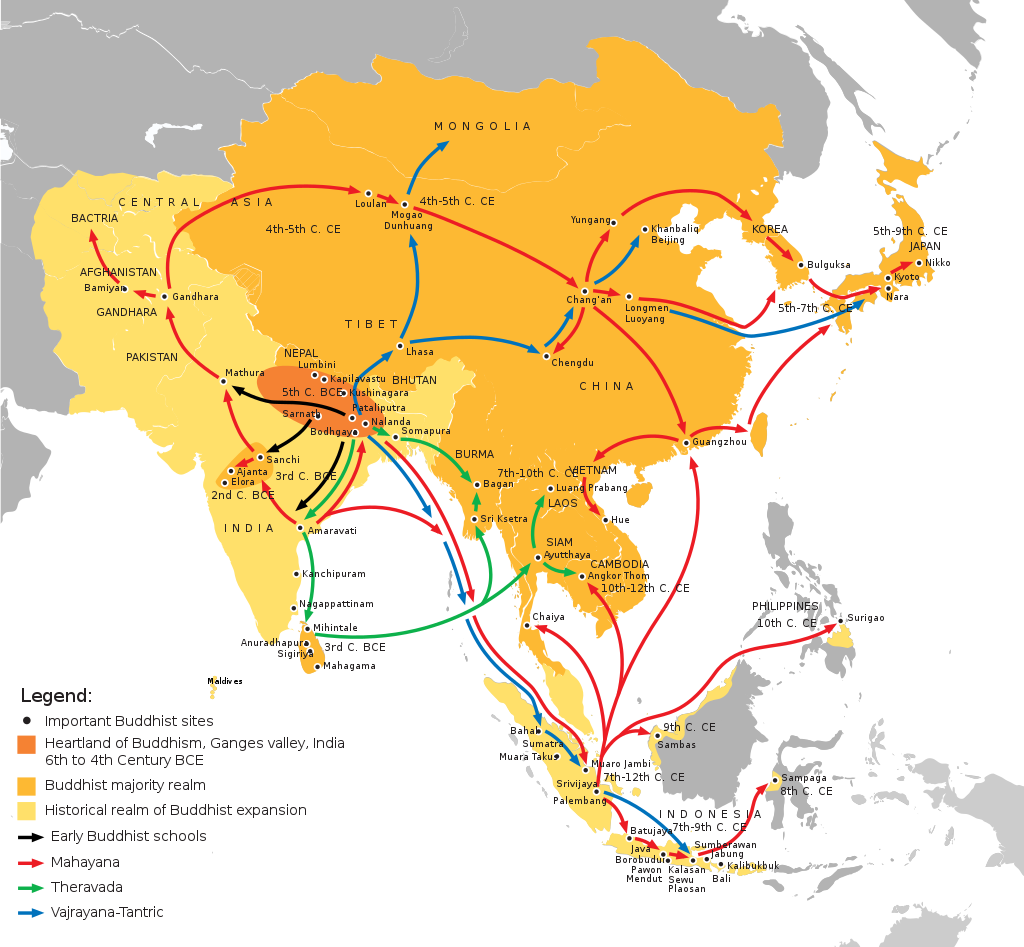
Aside from the shifting configuration of kingdoms, perhaps the most notable development during the Period of Division was the introduction of Mahayana Buddhism (“Great Vehicle”) into China. Beginning in the 2nd century CE, at the end of the Han Dynasty, Buddhist merchants and monks from India and Central Asia brought their faith and scriptures to China through the Silk Roads and maritime trading routes. The impact was immense and can be compared to the Christianization of the Mediterranean region, and the spread of devotional forms of Hinduism in South Asia during this same period of time. Historians estimate that by the time the Sui Dynasty reunited China four centuries later, China had approximately 33,000 Buddhist temples and two million monks and nuns. Buddhism had become a large-scale religious organization evidenced by these temples, clerics, and scriptures, as well as being a widespread, popular faith that captured the imagination of common people and rulers alike.
Historians have hypothesized why this successful spread occurred. First of all, Buddhism clearly met a spiritual need. During the Period of Division, turmoil from rapid political change and constant warfare brought much suffering and instability to people’s lives. Now there was a religion that explained their suffering with notions of karma and rebirth and also offered the hope of paths to salvation and enlightenment. Buddhism placed the world amidst visions of multiple hells and heavens where merciful Buddhas and Bodhisattvas worked for the salvation of all beings.
Buddhism appealed to people in different ways. For scholarly elites living in capital cities or as hermits in mountain retreats, Buddhist doctrines about the nature of reality, self, and enlightenment were appealing because they seemed similar to concepts in Daoist philosophy. Both philosophies questioned the reality of ordinary understandings of the self and world, emphasized that our desires create an illusory world, and offered techniques for achieving liberation. Nirvana, for instance, was compared to the Dao (Daoist “Way”).
For rulers, Buddhism served political purposes. Since the faith became so popular, rulers who took vows and sponsored temple construction and the ordination of monks looked good because they were upholding the dharma, that is, the Buddhist law. Some even went so far as to have monks recognize them as incarnate Buddhas. Lastly, Buddhist monks – whether foreign or Chinese – were some of the most educated people at their courts and could assist rulers with mundane matters like international relations as well as esoteric ones such as spells and divination. Monks won support by promising that their rituals and incantations had magical potency.
Lastly, for most people, Buddhism was a devotional religion. Buddhas and Bodhisattvas were merciful beings to be worshiped because of their good karma which potentially benefited all beings. By going to a temple and burning incense or praying and making offerings before a Buddha statue, the faithful might have a simple wish granted: an illness cured, loved ones helped, or a better rebirth ensured.
The first of the systems of Mahayana thought to become common in China was esoteric Buddhism, primarily Tien Tai (in Japan, Tendai) an esoteric sect with secret rituals, and a magical element. This form of Buddhism limited those who could join to those who were literate so that they could understand the secret knowledge and ceremonies. Tien Tai devotees also had to have time and money to spend on ceremonies. To answer the needs of common Chinese, however, who had neither the money nor the time for esoteric Buddhism, monks found ways to make Buddhism popularly accessible. A major sect these pursuits led to became known as Pure Land Buddhism. This sect had far more mass appeal because it took less time and effort to learn and practice, and taught anyone could be saved. Doctrinally, Pure Land Buddhism required study of Buddhist thought, and meditation when possible. In practice, it required only a simple invocation, repeated often, and with sincerity. If one appealed regularly to a bodhisattva known as Amitabha, (Amida Buddha in Japanese), Amitabha would collect one’s soul at death and transport one into nirvana. In some instances, the image went so far as to suggest the mode of transportation would be on a cloud, or a ray of light. Nirvana in this style of Buddhism was characterized more as a place than a state of existence/non-existence as espoused by Siddhartha Gautama. A later sect, True Pure Land Buddhism, was even more universal. In this sect, it was assumed that a single, sincere invocation of the name of Amitabha was enough to bring salvation. Repetition was unnecessary as long as the invocation was sincere. This popularization of ideas and practices made it possible for anyone to adopt Buddhism at any time, from any walk of life, and thus gave hope of personal salvation, and a sense of equality, at least in spiritual matters, to any and all who might consider Buddhism.
Modern Issues – The Dynastic Cycle, The Mandate of Heaven, and The Chinese Revolution of 1949
One of the most-discussed questions in the field of Modern Chinese history is how to account for the Chinese Revolution of 1949. Was it a truly modern revolution, as the Chinese Communist Party claims? Was it the end of traditional Chinese history and the beginning of something new? Or is it better explained by ideas stemming from the Mandate of Heaven?
The Mandate of Heaven is an ancient idea that reflects traditional Chinese understanding of the meaning of history. Sima Qian (c.145 – c.86 BCE) the father of Chinese history, may have been the first to think deeply about this in his book The Records of the Grand Historian (shiji in Chinese). His work is the most complete history of ancient China that survives. He created the Chinese way of conceiving history. Thinking of history as a cycle leads to questions for modern historians about what history is, what causes historical change, and even how to think about time.
The Zhou Dynasty created the concept of the Mandate of Heaven and used it to justify their replacement of the Shang Dynasty. The idea was that the gods (Heaven) decided who deserved to rule based on how well they served China and its people. When a ruling family no longer served China, which meant that they were no longer behaving morally, the gods replaced them. The idea was simple. If a dynasty was not serving China, nature, reflecting Heaven’s condemnation, would react. There would be earthquakes and volcanic eruptions. People would turn to banditry and crime, or rebel against the Empire. These were signs from the gods that things were not okay. If the Dynasty did not reform, then other local rulers would rebel and begin a civil war. The winners of the war would become the new rulers of China. Once again, Heaven expected them to rule morally and to care for China. Since the mandate to rule came from Heaven, it was called the “Mandate of Heaven.”
It is important to recognize that this is not like democracy or revolution in Western history. The dynasty did not change because “the people” were unhappy. Instead, people being unhappy was just one of many signs that the emperors in the dynasty were not pleasing Heaven. No one had the right to vote on national politics, and the dynasty was not reacting to popular opinion. The Mandate of Heaven was judged and determined by the gods, not “the people.” Political philosophers, including Confucius and Sima Qian, thought the Mandate of Heaven was the key to successfully ruling China. They also believed that dynasties changed according to a cyclical Dynastic Cycle that governed Chinese history. They reasoned that a new dynasty must try to show that it deserved the Mandate of Heaven. Doing so often included dividing up large estates so that more people could own their own land. It included tax reforms to make life easier. Usually, new dynasties made laws kinder, and they reduced forced-labor requirements.
Every early dynasty period was a kind of honeymoon. It was not an attempt to please the people; it was an attempt to show to the people that Heaven had given it the mandate to rule and to demonstrate to Heaven the moral basis of its rule. A good example of this would be the reign of Liu Bang, or Han Gaozi – his reign name. The first Han emperor, he was a reformer. Though he maintained the strict legal codes of the Qin Dynasty he then staffed his administration with Confucian scholars who administered the law with kindness.
As time passed, the rulers and their administrators benefited from experience. Taxes might rise a bit, but their application and use would be more efficient. Less effort would be needed to rule the empire. The rulers and their officials demonstrated they knew what they were doing. A great example of this might be the reign of Emperor Qianlong during the Qing Dynasty. China in 1700 had the world’s most powerful army and the world’s largest economy.
The cycle ended when rulers were less interested in ruling. They became more interested in enriching themselves. These administrations tended to be corrupt. The emperor was not setting an example of moral behavior for his people. Such an emperor could not help China in times of need, and often did not even recognize the needs of the people. In these cases, the emperor either failed to defend China from its enemies or willfully mistreated the people. Moral failure led to natural disasters. These were signs that the emperor had displeased Heaven. Without reforms, the gods would bring a civil war and give the Mandate of Heaven to a new family. From Sima Qian onwards, the Dynastic Cycle provided the key pattern for interpreting Chinese history. Confucius’ philosophy amplified the ideas of the Mandate of Heaven and the Dynastic Cycle. Historians and politicians explained history based on them. The question was always about how the current ruler was fulfilling the Mandate of Heaven.
In 1911 CE the last Emperor of the Qing Dynasty lost his throne. Some explained it as part of the Dynastic Cycle. In 1949, a new Communist government won a civil war and took control. The Communists claimed this was the end of traditional history. They did not think of their government as imperial in any way. They did claim they were equalizing the wealth gap among China’s people. They promised to stamp out corruption. They ended smuggling, gang turf wars, the opium trade, sexism, and crime. The Chinese Communist Party (CCP) under Mao made it clear that the Dynastic Cycle had ended. But, ironically, their actions fit the pattern of a new dynasty.
The Chinese Communist Party’s political philosophy had its roots in a non-cyclical Western-style view of linear history. Mao claimed to interrupt the Dynastic Cycle by ending the reign of emperors altogether. What is interesting though, is the degree to which the Communist Party’s actions continued to fit into the Dynastic Cycle theory. This gives us a chance to see that there is more than one way to interpret general historical principles. It is not that the Dynasty Cycle is right so much as it has just as much explanatory power as the way Western people look at history, despite the differences in interpreting time. Western historians see time as a line moving forward. Chinese historians see it as a cycle moving upward.
The Dynastic Cycle is a theory of how history works. It is no more nor less true than Western linear history, or any other way of seeing time. In fact, we have many ways of layering patterns on events to fit our interpretations. It is possible to imagine the events of the 20th century in China as fitting in with the Dynastic Cycle. It is equally possible to see them as a part of a linear timeline. Similarly, if we wish, we can reinterpret European or American history within a cyclical framework. Perhaps viewpoint is the key difference. The Chinese Communist Party thought of itself as the end of China’s cyclical historical tradition. Maybe that means that the Communist Party and its historical analysts see history in a new way. Maybe the way we see the past is conditioned by the way in which we imagine that time works.
The Chinese Communist Party has so far not failed nor collapsed. It has, however, gone through many changes since 1949. We won’t know the results of their ideological and political experiment in escaping the cycle until it is over. The cycle has to continue in order to judge whether it is, in fact, a cycle. The question is not just about China but about how history works. Were Sima Qian and the Dynastic Cycle paradigm correct? Is history a working out of heavenly morality within the context of human society? Or do we have more control than that? Is there a way for humans to change the future? Do we have free will – the power to act and change the course of history? This dichotomy in historical perspectives is one of the many things that make Chinese history so fascinating.
SUMMARY
China’s culture evolved over several millennia. The first major state was the Xia Dynasty (c. 1900–1600 BCE). Although historians debate whether or not it was legendary and lacks written sources from that time, the archaeological evidence points to a Bronze Age civilization with a capital city at Erlitou. The next dynasty, the Shang (c. 1600 – 1046 BCE), left written evidence in the form of oracle bones and bronze inscriptions. The last Shang capital was located at Anyang on the North China Plain near the Yellow River. The dynasty’s most important legacies were the earliest form of Chinese writing and ancestor worship. The oracle bones were used to divine the will of higher powers and the spirits of deceased Shang kings.
The next dynasty, the Zhou Dynasty (1045–256 BCE), began when chieftains to the west of the Shang declared themselves kings and overthrew it. They justified doing so with the Mandate of Heaven, which states that a higher power withdraws its support from corrupt ruling families and transfers it to righteous ones. Because it lasted 800 years and saw much change, the Zhou is divided into two major periods, the Western (1045 – 771 BCE) and Eastern Zhou (770–256 BCE). During the Western Zhou, Zhou kings ruled by granting land and noble titles to kinsmen and allies in exchange for loyalty and service. The resulting political system, which saw China divided into over one hundred feudal states, is known as Zhou feudalism. During the Eastern Zhou, this nobility became increasingly independent and fought with each other for power and territory. A few declared themselves kings and forged powerful militaries by gearing their kingdoms for war. The Warring States Period took place with the end of effective central rule by the Zhou, leading to centuries of bloodshed. In the end, in 221 BCE, the state of Qin prevailed, initiating China’s imperial era. In the midst of the dislocation caused by Eastern Zhou instability, three of China’s major philosophical traditions emerged: Confucianism, Legalism, and Daoism.
The short-lived Qin Dynasty was followed by the much longer-lasting Han Dynasty (202 BCE–220 CE). During the Han Dynasty, Confucianism was adopted as the governing philosophy and also permeated society, shaping the Chinese worldview. The Han also became an empire, as borders were expanded in all directions. During the reign of Emperor Wu (141–87 BCE), China extended control over parts of Korea, northern Vietnam, and also much of Central Asia. The resulting stability and the productivity of the economy spurred the development of the Silk Routes.
WORKS CITED AND FURTHER READING
- Confucius. n.d. “Confucian Thought.” Confucian Thought. Accessed August 11, 2023. http://www.olemiss.edu/courses/inst203/confucianthought.pdf.
- Gernet, Jacques. 1996. A History of Chinese Civilization. 2nd ed. Cambridge: Cambridge University Press
- Feng, Li. 2013. Early China: A Social and Cultural History. Cambridge University Press
- Hwang, Kyung Moon. 2010. A History of Korea. Palgrave Macmillan.
- Keally, Charles. n.d. “Yayoi Culture.” http://www.t-net.ne.jp/~keally/yayoi.html.
- Keally, Charles. n.d. “Jōmon Culture.” http://www.t-net.ne.jp/~keally/jomon.html.
- Kuhn, Dieter. 2009. The Age of Confucian Rule: The Song Transformation of China. Cambridge: Harvard University Press.
- Laozi. n.d. “Tao Te Ching (Dao De Jing) Classic of the Way and Virtue.” Ripening Peaches. https://www.egreenway.com/taoism/
- Lee, Ki-baik. 1984. A New History of Korea. Cambridge: Harvard University Press.
- Lewis, Mark Edward. 1989. Sanctioned Violence in Early China. Albany: Statue University of New York Press.
- ———. 2009. China’s Cosmopolitan Empire: The Tang Dynasty. Cambridge: Harvard University Press.
- ———. 2010. China between Empires: The Northern and Southern Dynasties. Cambridge: Harvard University Press.
- Loewe, Michael. 2005. Everyday Life in Imperial China. Indianapolis: Hackett Publishing.
-
Mote, Frederick. 1999. Imperial China,900 – 1800. Cambridge: Harvard University Press.
-
Normile, Dennis. 2016. “Massive Flood May Have Led to China’s Earliest Empire.” Science, August 4, 2016. https://www.science.org/content/article/massive-flood-may-have-led-chinas-earliest-empire#:~:text=The%20devastating%20flood%20could%20have,Yellow%20River%20and%20its%20tributaries.
-
Peers, C.J. 2006. “Soldiers of the Dragon.” In Chinese Armies 1500 BC – AD 1850. Oxford: Osprey Publishing.
-
Pines, Yuri, ed. 2014. Birth of an Empire: The State of Qin Revisited. Berkeley: University of California Press.
-
Robinet, Isabelle. 1997. Taoism: Growth of a Religion. Stanford: Stanford University Press.
-
Rossabi, Morris. n.d. “The Mongols in World History.” http://afe.easia.columbia.edu/mongols/index.html.
-
Sunzi. n.d. “Sunzi’s (Master Sun’s) Art of War.” Sunzi’s (Master Sun’s) Art of War. Accessed August 11, 2023. http://afe.easia.columbia.edu/ps/cup/sunzi_art_of_war.pdf.
-
Tanner, Harold M. 2010. China: A History, Volume I: From Neolithic Cultures through the Great Qing Empire. Indianapolis: Hackett Publishing Company.
-
Temple, Robert. 2007. The Genius of China: 3,000 Years of Science, Discovery and Invention. Rochester: Inner Traditions.
-
Totman, Conrad. 2000. A History of Japan. Oxford: Blackwell Publishers.

